Design can bring a human-centered set of strategies to those working on justice innovation. How do we make legal services, courts, and administrative agencies that people can and want to use?
Can we design better technology solutions to let people build their legal capacity? To empower people with legal knowledge?
Can we design better information and communications, to help people learn how the justice system works? And how to navigate it?
And can we design better laws, policies, and system-level changes that make a justice system that lets people meaningfully participate in courts, and other justice decisions?
These posts cover what such interventions have been tried before, how they have fared, and what other measures might be tried in the future.
You can see more of my project work with the Stanford Legal Design Lab on justice system innovations here at our Justice Innovation page!
My posts on Access to Justice Innovations

Beagle+ AI legal help chatbot
The British Columbia, Canada group People’s Law School has an OpenAI-powered chatbot to help people get legal information: Beagle+. You can try out the Beagle+ Chatbot here, or explore the sample below. I asked it about my landlord not…

10 Guidelines for legal help information
Lois Lupica, working with IAALS and the Bohemian Foundation, made a guide for legal help providers about how to effectively communicate information to the public about the legal system and their rights. At the link, find the pdf of…
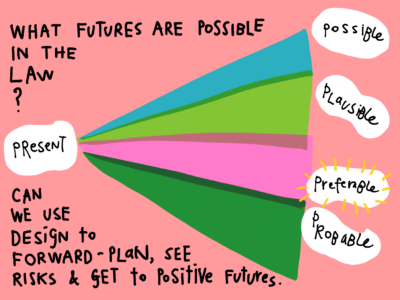
Speculative Legal Design to think big about system reform
At this year’s Legal Design Roundtable in Brussels, many legal designers presented on what methods they are using for legal reform. One main theme was around Speculative Design, in which groups of users and experts create future visions —…
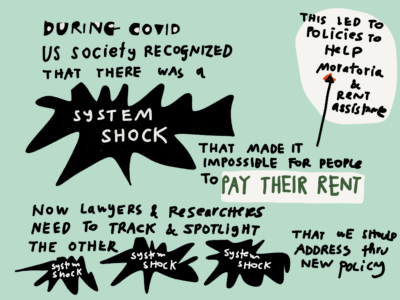
System Shocks & A2J Policy
At last week’s Access to Justice Symposium hosted by the Stanford Law Review, I was on a panel about A2J and housing, with a focus on evictions. What are the policies and services that can prevent evictions, or mitigate…
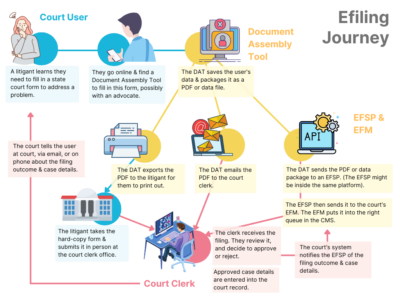
Making complicated court & efiling tech clear
As part of my access to justice innovation work, I realize one big barrier to change is understanding how systems currently operate. For example, filing and court technology is confusing. There are lots of acronyms and interrelated systems: efiling…
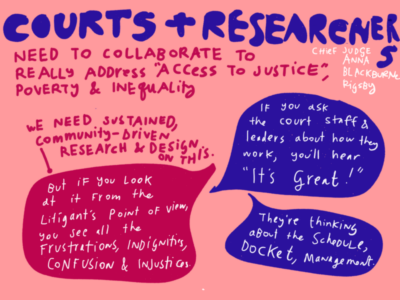
Research-Practitioner Loop in Access to Justice work
Last week I had a double conference weekend in DC. The first was with front-line lawyers and executive directors at legal aid groups and public defender officers. The second was with academics and researchers, who are studying the access…
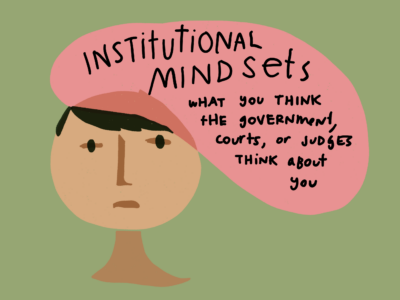
Institutional Mindset for people in court
Victor Quintanilla presented at Georgetown Law/American Bar Foundation on his research on people’s experience of courts. He’s measuring people’s social psychology while going through a justice journey – -including how they are treated by court and legal services staff…
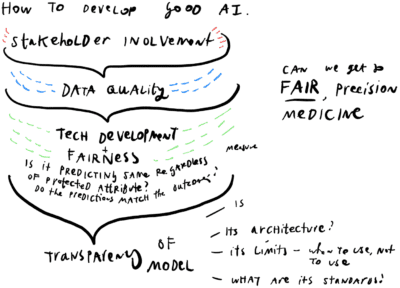
What can legal learn from medical when it comes to ethical AI?
Can legal practitioners, particularly those working on access to justice, learn from how AI is being rolled out in medical systems? Can we borrow their typology of AI — and also the problems with equity and bias in past…
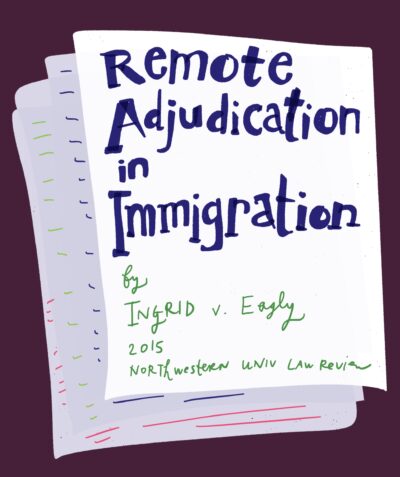
Does virtual court mean more or less meaningful participation by litigants?
What research can we do to understand if virtual hearings improve or degrade the quality of justice that civil litigants get in courts?
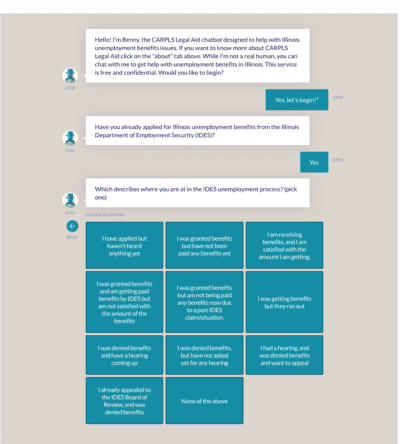
Benny, the legal aid unemployment benefits chatbot
On a recent conference call, someone pointed out a new bot from the CARPLS legal aid group in Illinois: Benny, a conversational bot that can help a person with their unemployment public benefits situation. From CARPLS, here’s a quick…
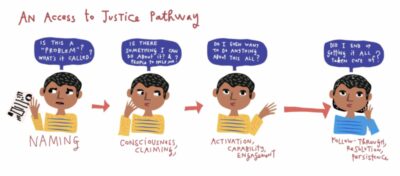
The Access to Justice Pathway: from naming to claiming to action
How do we activate people along the Justice pathway?I am lucky to be in a wonderful group of young scholars focused on access to Justice, with support from the American Bar Foundation and the JPB Foundation. At our event…
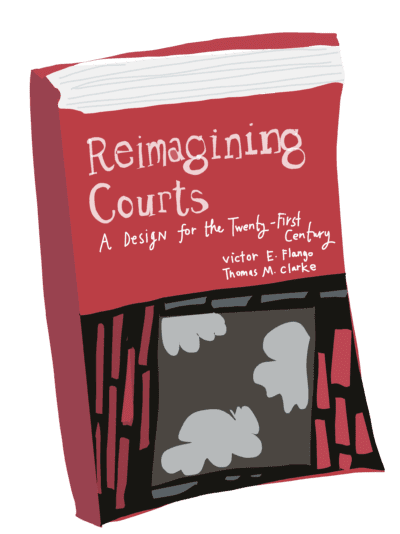
Must Read: Reimagining Courts, a design for the 21st century
Reimagining Courts collects data and ideas for how the court system in the United States might be improved to be more human-centered and more efficient. It looks at what is happening inside of different types of court systems in…
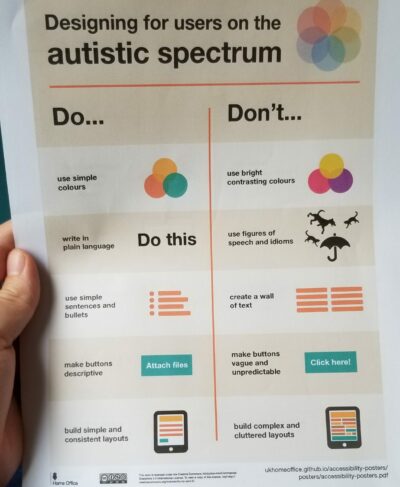
Design rules for accessible civic websites
Here is a terrific visual guide for all those making legal aid, court, or government help websites. It is from the Gov.UK team, and it lays out key principles and design patterns for more accessible websites and apps. Thanks…
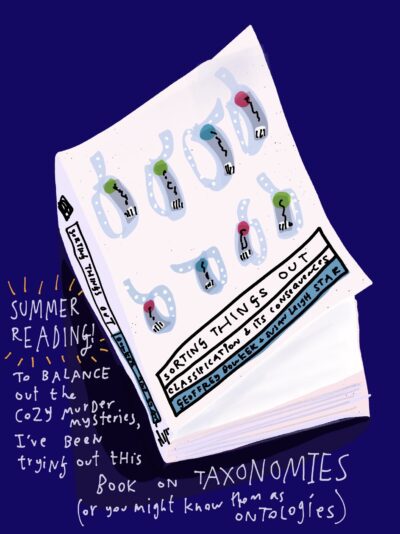
How do we make a good taxonomy of legal problems?
I have been working on the giant effort to make a comprehensive, user-centered taxonomy of legal issues that people have in the US. It’s called LIST, Legal Issues Taxonomy, and up in its growing glory at the site https://taxonomy.legal….
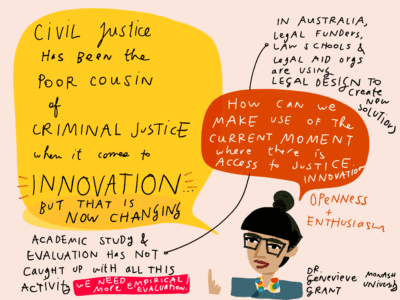
How can legal design work be evaluated?
From day 2 of the Digital Citizens conference at the University of Melbourne, Dr. Genevieve Grant of Monash University presented on how rigorous outcome, process, and ethical evaluation could be brought into legal design work. The points are quite…
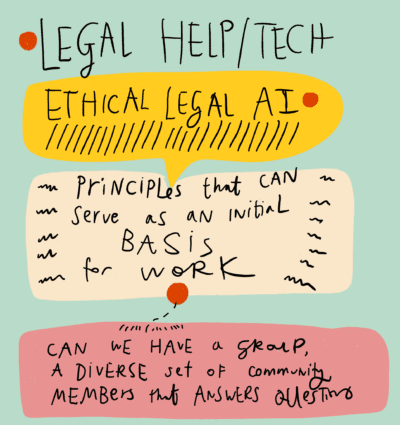
This Year’s LSC ITCon in Pictures + Drawings
January’s Legal Services Corporation ITCon (the conference formerly known as TIG) is the best place for legal aid technology geeks. Someone explicitly called me a geek at this conference, and it is true. This conference brings together several hundred…
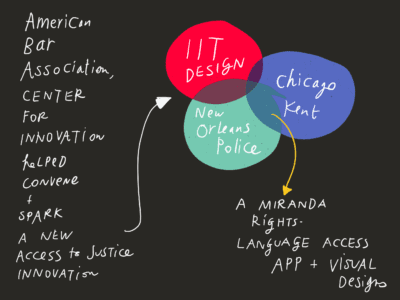
Taking stock of our current state of legal help digital tools
Yesterday I went to the ABA Midyear meeting to attend the Center for Innovation meeting, and also sit in on a session about ‘Maybe there’s an app for that…’ about how technology is playing into the access to justice…
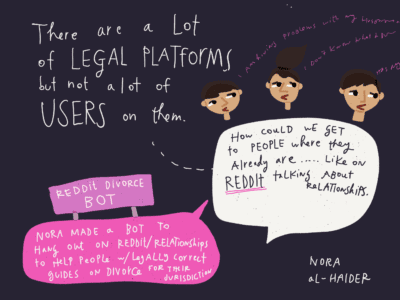
Designing a bot to proactively connect Redditors with legal help #LDsign18
How do we design access to justice tools that get out to where people with legal problems already are — and not expect them to come to new platforms? This project comes from Nora al-Haider who has created a…
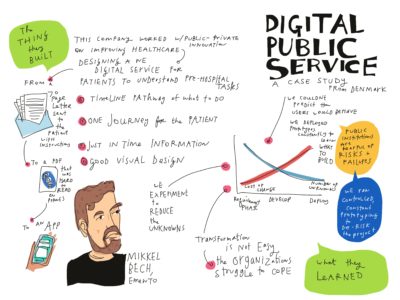
Experimenting with digital public services, in health #xbd2018
One case study on Experimentation By Design, around digital transformation of information for patients coming into the hospital. This comes from a Danish startup Emento that has built a better guide and notification system through a series of prototypes…
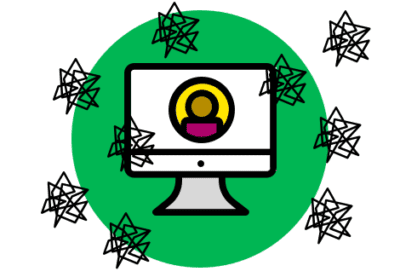
What Law can learn from Digital Epidemiology
There is an interesting movement in public health research, around using people’s online posts, clicks, website visits, searches, and other behavior to better understand what health issues are: see Digital epidemiology: tracking diseases in the mobile age. Could we have…
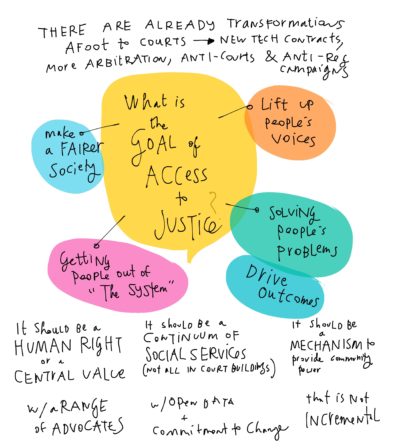
Steps toward a coherent Access to Justice movement
My sketches and notes for how our current loose coalition around Access to Justice could be stronger and more coherent — from the Fordham law A2J Summit today.
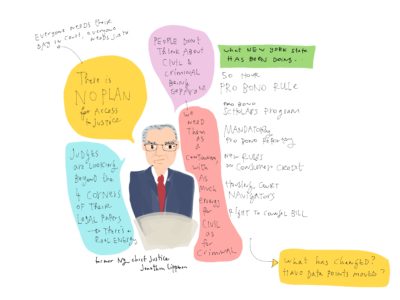
Where is the Plan for Access to Justice?
A vision of how an Access to Justice movement might blossom, with more judges involved –and with many examples from New York. From the former chief Justice of New York, Jonathan Lippman.
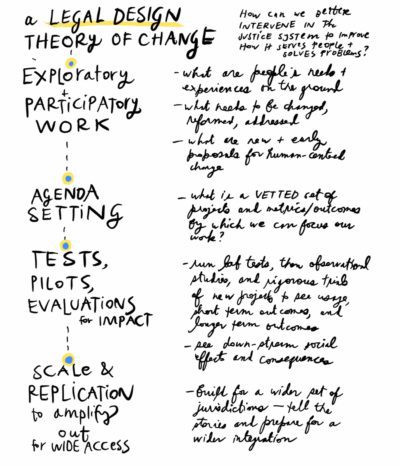
A theory of change for Legal Design work
I have been reading a tremendous amount of policy and design literature, to find some worthwhile grounding of my Lab’s design work in the civil justice sphere, in other academic and policy literature that is also concerned with creative,…
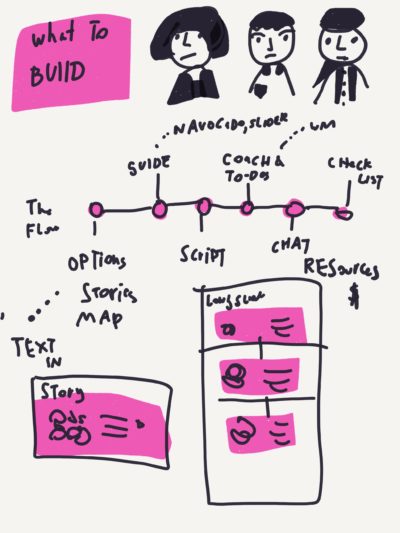
Testing out new legal bots + chat-based coaches
After doing a few months of user testing in courts, testing out different ideas for innovation — I’m more intent on chat-based, dialogue tools as a promising way to increase access to justice. This means we need to focus…
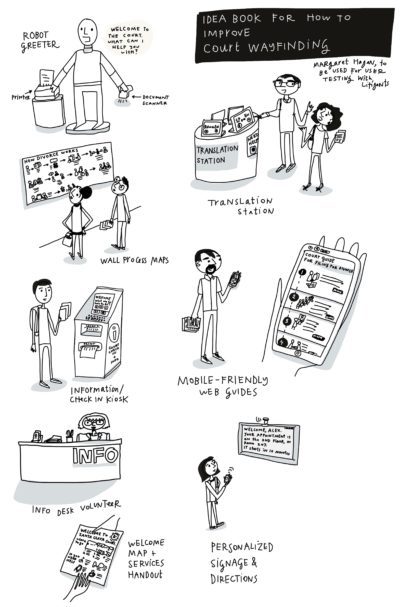
8 Ideas for Better Court wayfinding
For the court user testing I am working on at the Legal Design Lab, we have been testing different ideas to make court process more navigable — getting litigants’feedback and agenda on them. Now, we will turn to a…
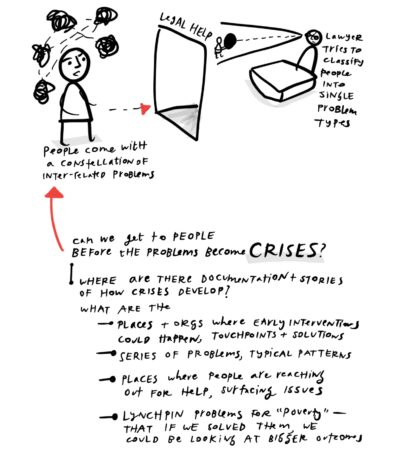
Preventative Approaches to Legal Help
If we frame access to justice innovation around scouting what problems people have that might lead to legal or life crisis finding patterns of issues and how they proceed finding where people are reaching out for help, seeking resources…
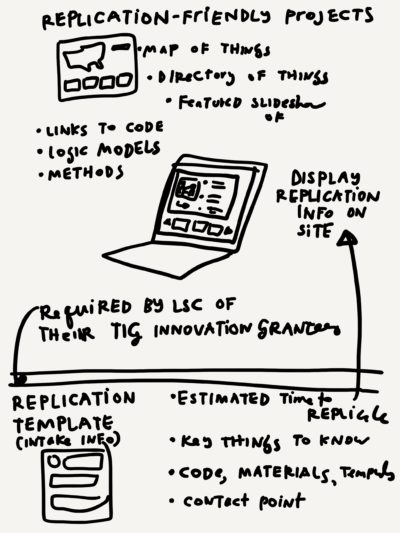
How do we encourage legal service innovation replication?
One of the teams in my Intro to Legal Design class this quarter is working with Legal Services of North Florida to think through a replication strategy for their recent services innovations. In the process, they’ve refocused to a…
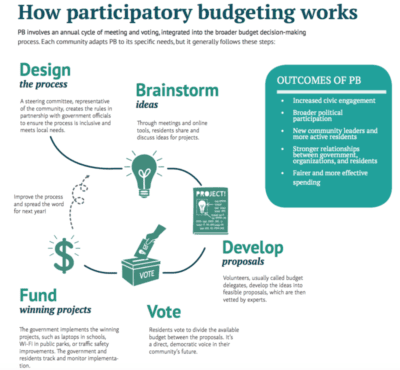
Participatory Budgeting as a way to involve more people in justice innovation
I have been teaching and writing on how the Access to Justice movement might improve its innovations by including a wider community in its policy-making. My colleague Verena Kontscheider recommended that I explore the new world of Participatory Budgeting,…
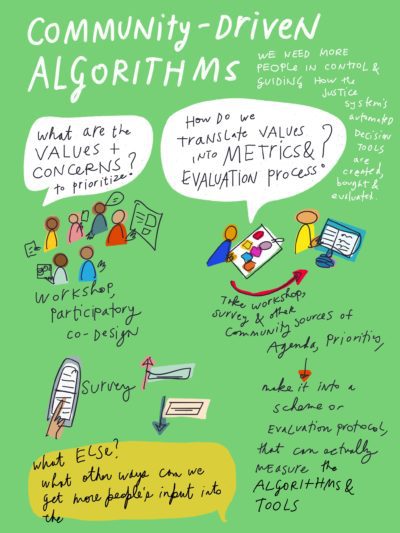
How do we have a wider community influence the algorithms in the justice system?
The hot topic at court and access to justice conferences this year has been around how to make the new wave of algorithms and automated decision tools more transparent and fair. I am interested in applying participatory and co-design…
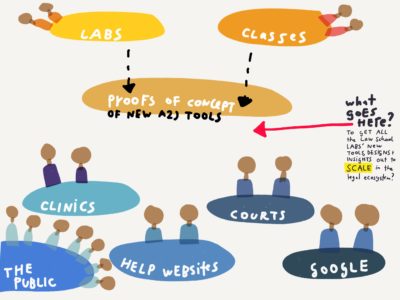
Scaling tools to system change for access to justice innovation
As more law school labs, hackathons, and innovation work lead to more individual products and services that aim to increase access to need to think about how to scale, maintain, and integrate them to make a significant improvement in…
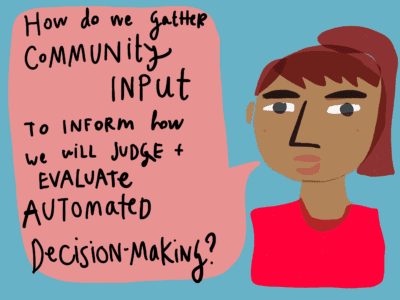
How do we plan for ethics and community with new AI in courts?
One of the best sessions at the SRLN 2018 conference in San Francisco in February was one on AI, Ethics, and Decision-making. Speaking at it were Angie Tripp, Jonathan Pyle, and Abhijeet Chavan. They raised difficult, necessary questions about…
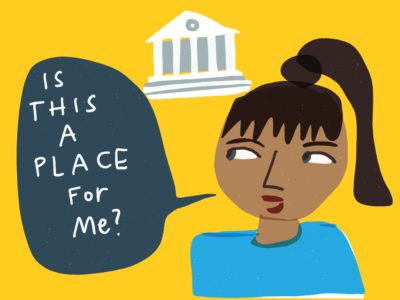
How do we get more community involved in justice innovation? Sketches from the SRLN conference
Last Friday, I attended the second day of the Self-Represented Litigation Network’s yearly conference in San Francisco. I presented on the text messenger I am building with Legal Design Lab for courts and legal aid groups, as well as…
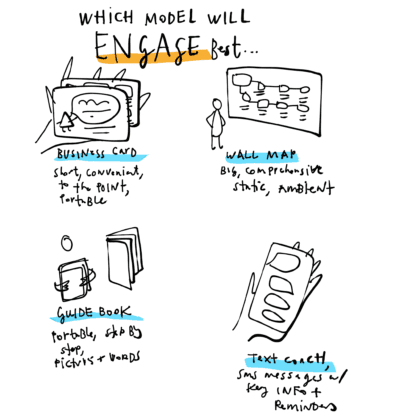
Testing engagement with different Access to Justice interventions
This year, my work at the Legal Design Lab is shifting from the strictly generative and experimental, to more evaluation and development. That means we’re not working so much on open design sprints, to spot new promising ideas, but…
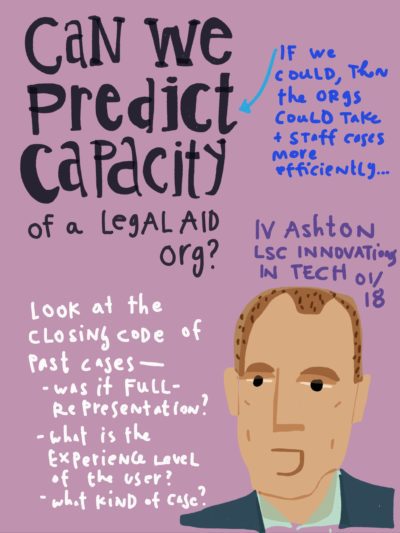
Sketching the LSC Innovations in Tech conference
Last week I was in New Orleans at one of the largest legal aid and self-help Innovacion conferences, sponsored by the Legal Services Corporation. I presented on a few panels, around community led system design, and around a better…
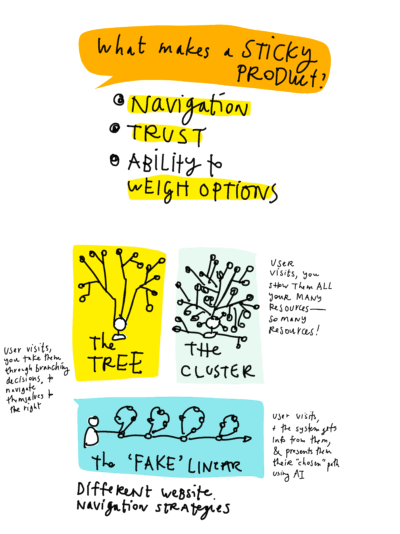
What are ways to structure online legal help resources?
A page from my notebook during a recent conference, all about structuring legal help online in better ways. Engagement is such a huge challenge — and we can think through different models to get people When we think about…
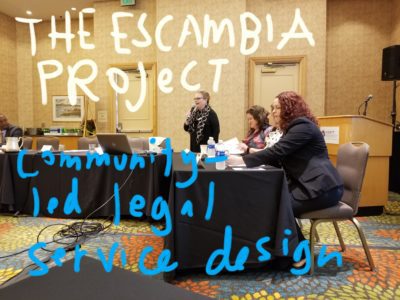
One year of legal community design in the Escambia Project
Last week I went to Orlando to participate in a share-out to the Florida Bar Foundation, by the core design team that worked over the past year to conduct a community-driven design process to create new legal services in…
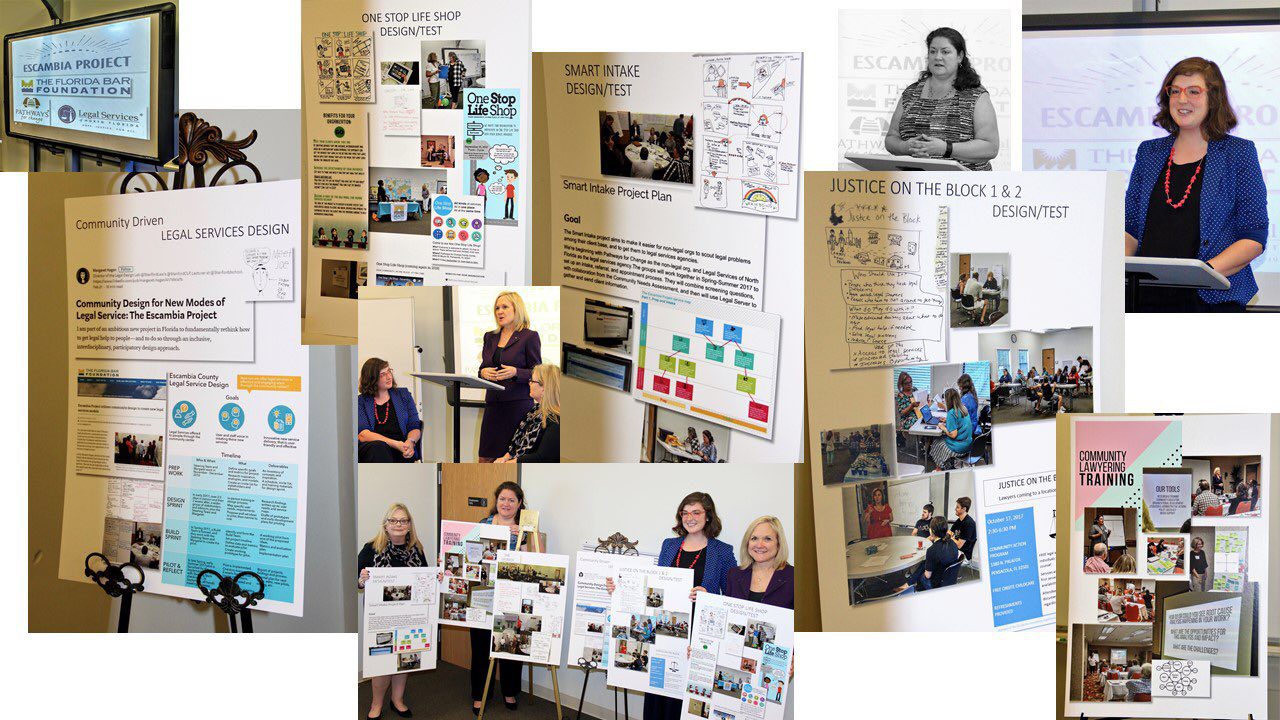
Escambia Project: community-driven legal design in Pensacola
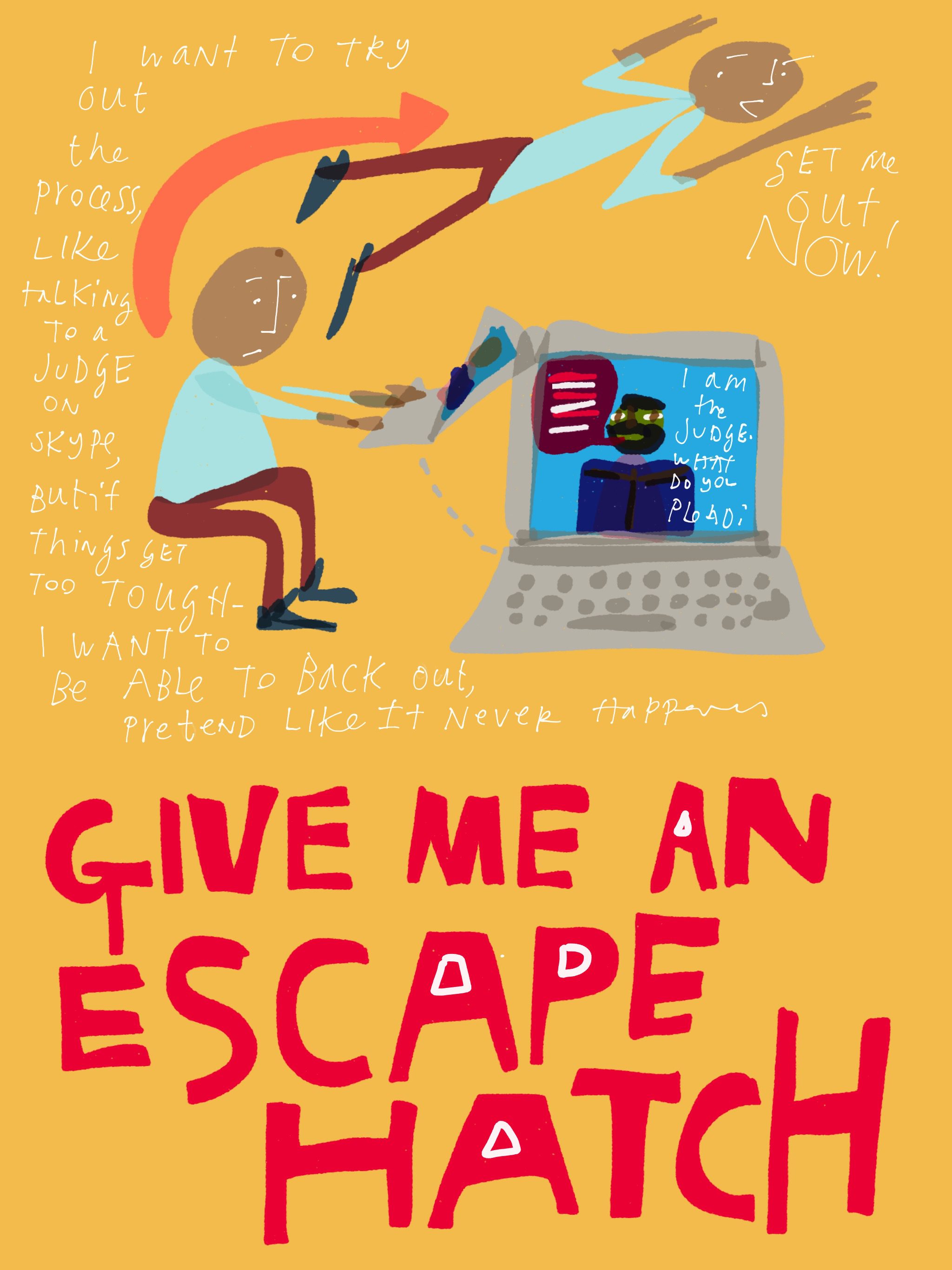
For online legal help, people need Escape Hatches
In some recent testing of possible online court scenarios (with “Wizard of Oz” prototyping — not really coding these online court scenarios), our research team has observed an interesting trend. Many users will click on a button to ‘Skype…
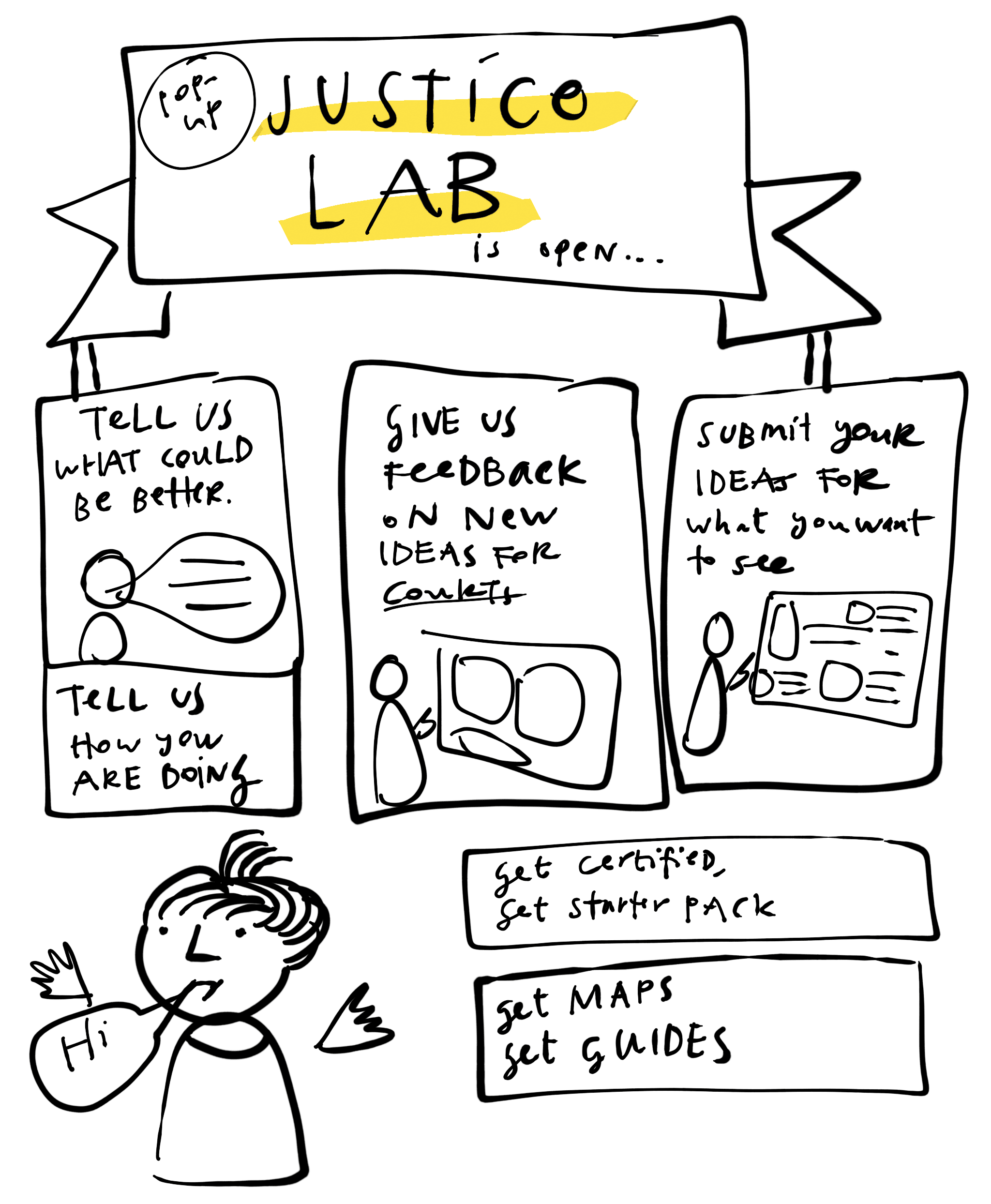
What might an on-the-street participatory justice lab be?
After reading and thinking about various participatory design and open innovation strategies, I’ve been brainstorming around how to get more community input into the redesign of the legal system. Could we have a roving laboratory, a pop-up place that…
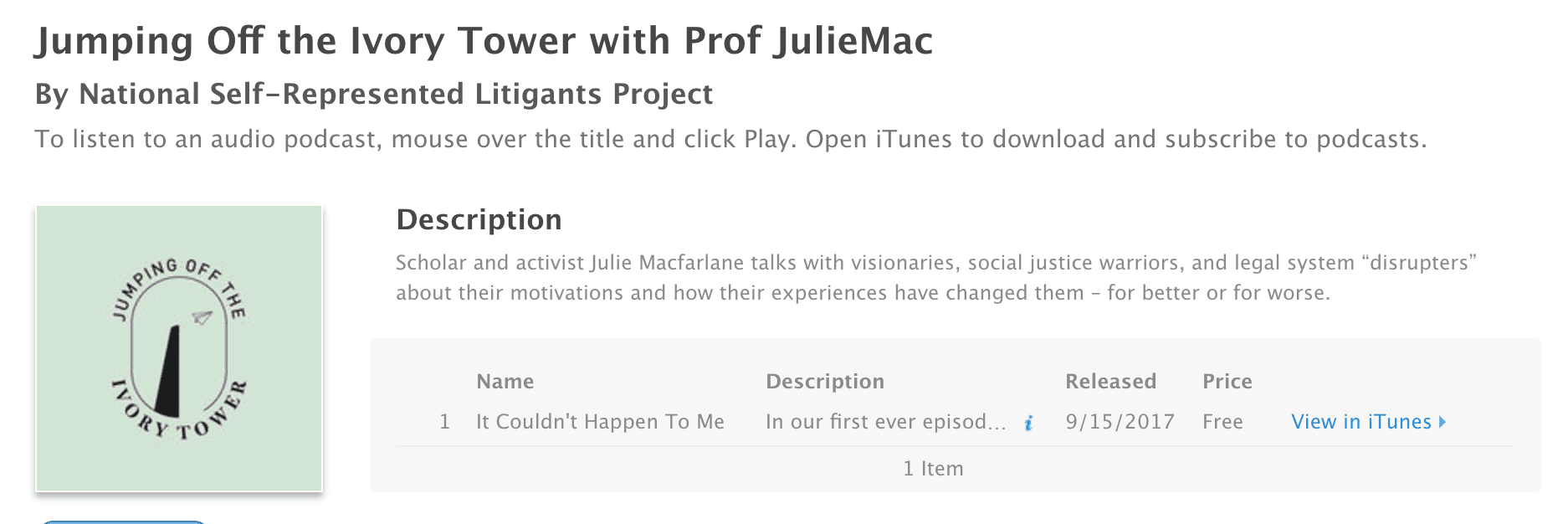
Jumping Off the Ivory Tower podcast
My listening this week: a podcast, Jumping Off the Ivory Tower, from Prof. Julie MacFarlane, of Canada’s National Self Represented Litigant Project. Here’s how Julie presents her vision for the podcast: Jumping Off the Ivory Tower with ProfJulieMac is a…
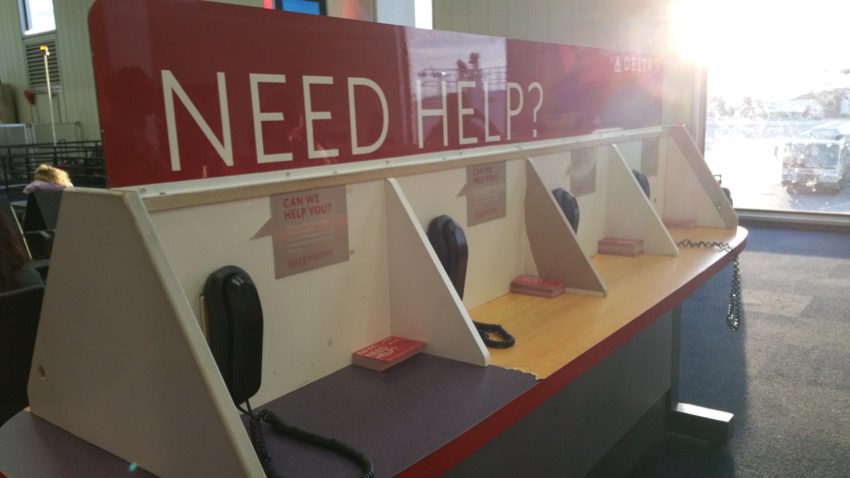
What can courts learn from airports for customer service?
I have been scouting out service design inspirations, particularly from airports, that courts could use. This one is from JFK airport, in the Delta terminal. I was very impressed with their service design. They had taken over an entire…
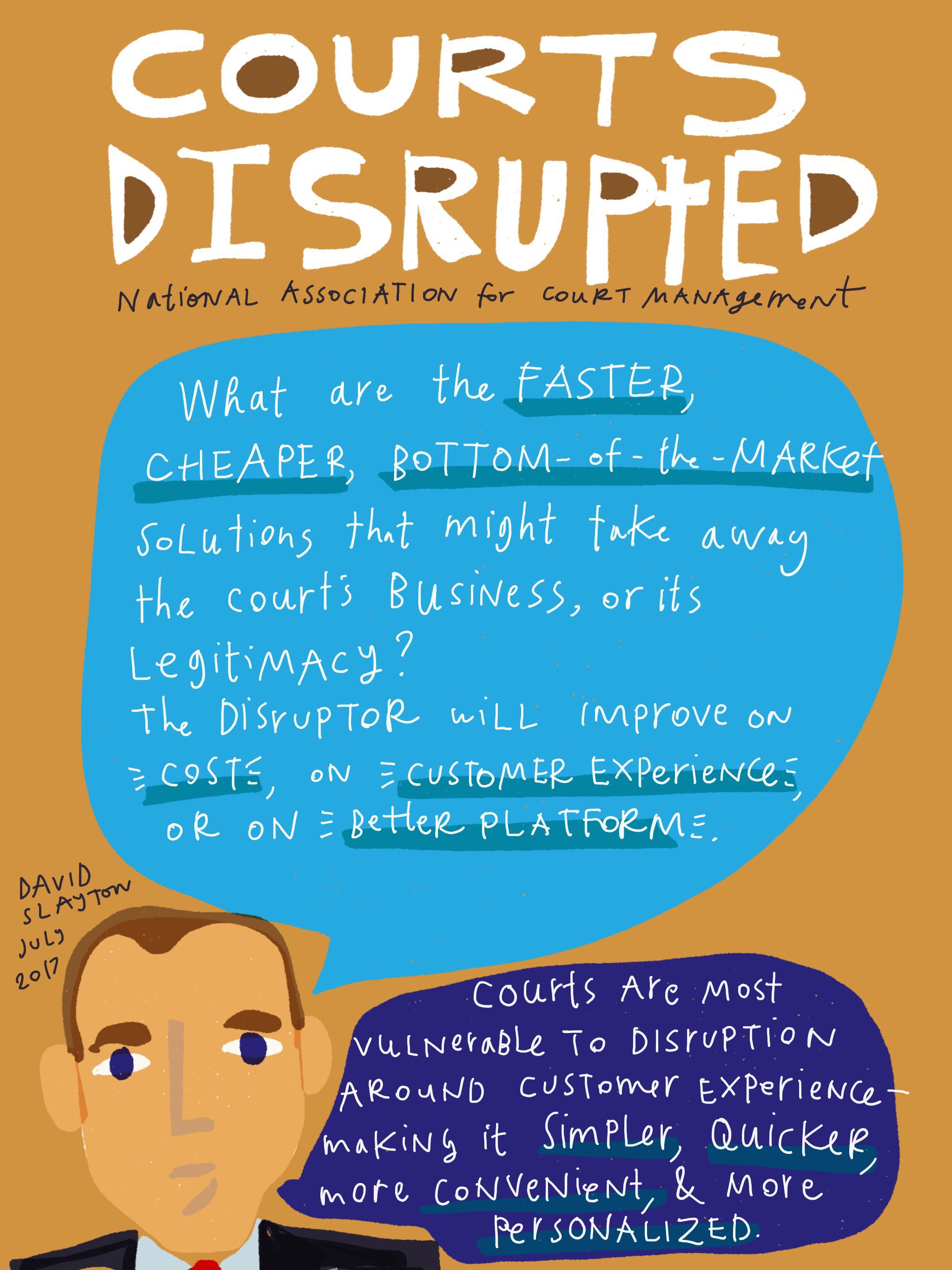
How will courts be disrupted?
Courts aren’t used to thinking about competition. Most have been used to be the only provider of dispute resolution. They haven’t had to think about the public as customers with choice. David Slayton, the court administrator of Texas scourts,…
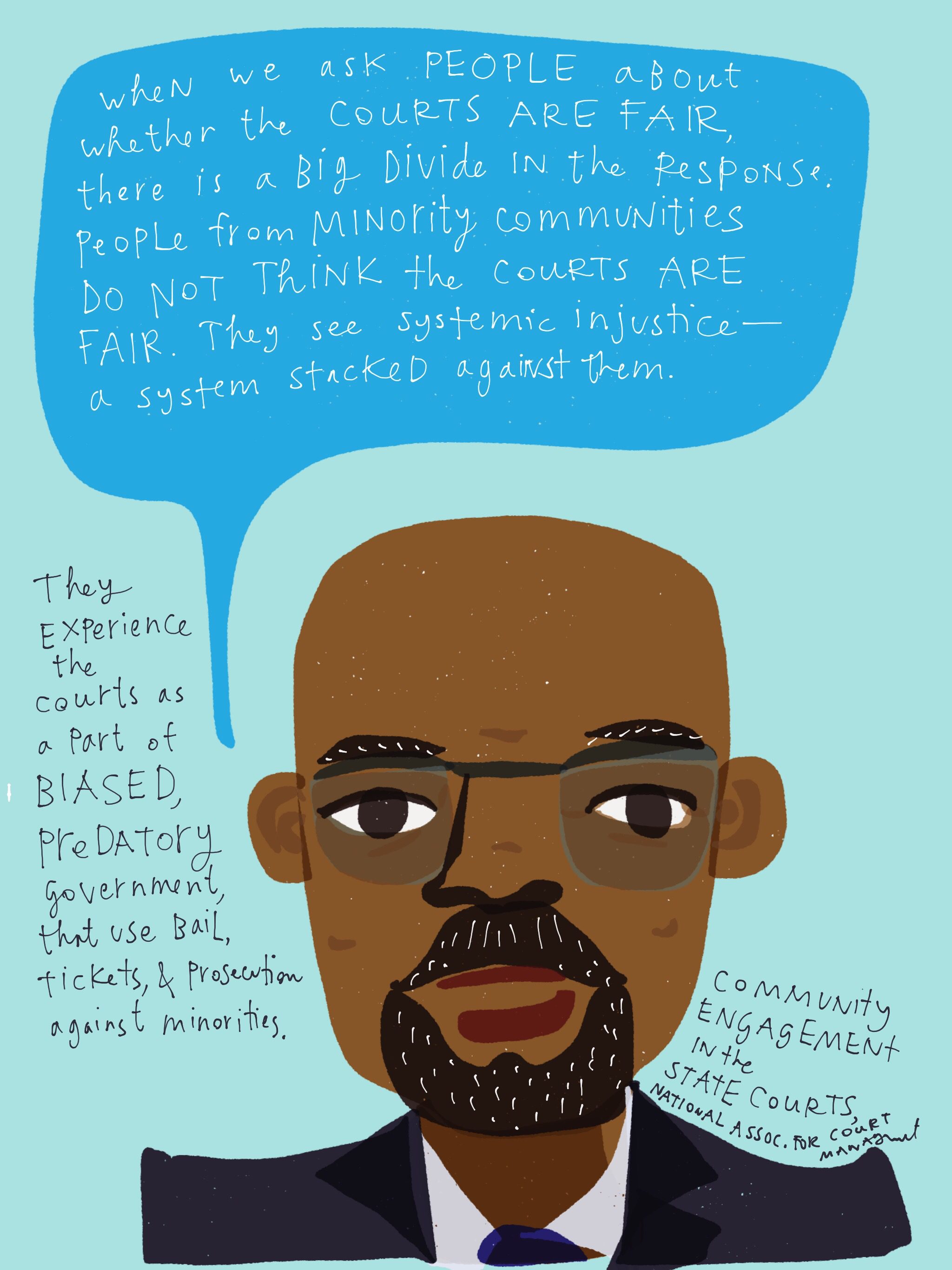
Why are courts struggling to engage (minority) communities?
At the National Association for court Management, I attended the session on how courts are focused on better engaging minority and disadvantaged communities. There are many dynamics that feed into the poor relationship: Predatory Practices by municipal courts -with…
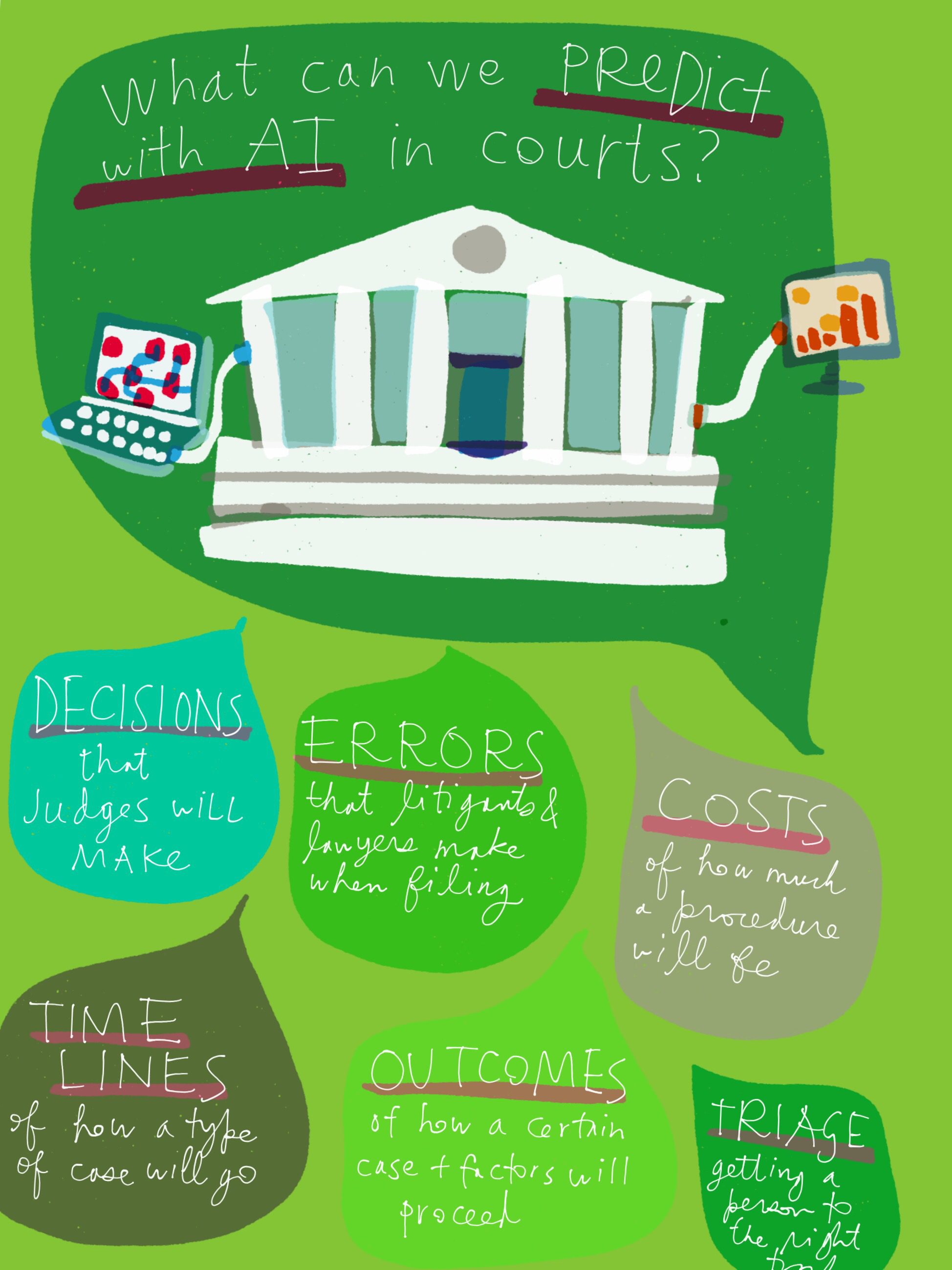
How can AI improve courts?
A quick sketch of some of the takeaways from a presentation I gave, along with Karl Branting of MITRE corporation at the National Association for court Management. We spoke on AI and Big Data in the courts, and what…
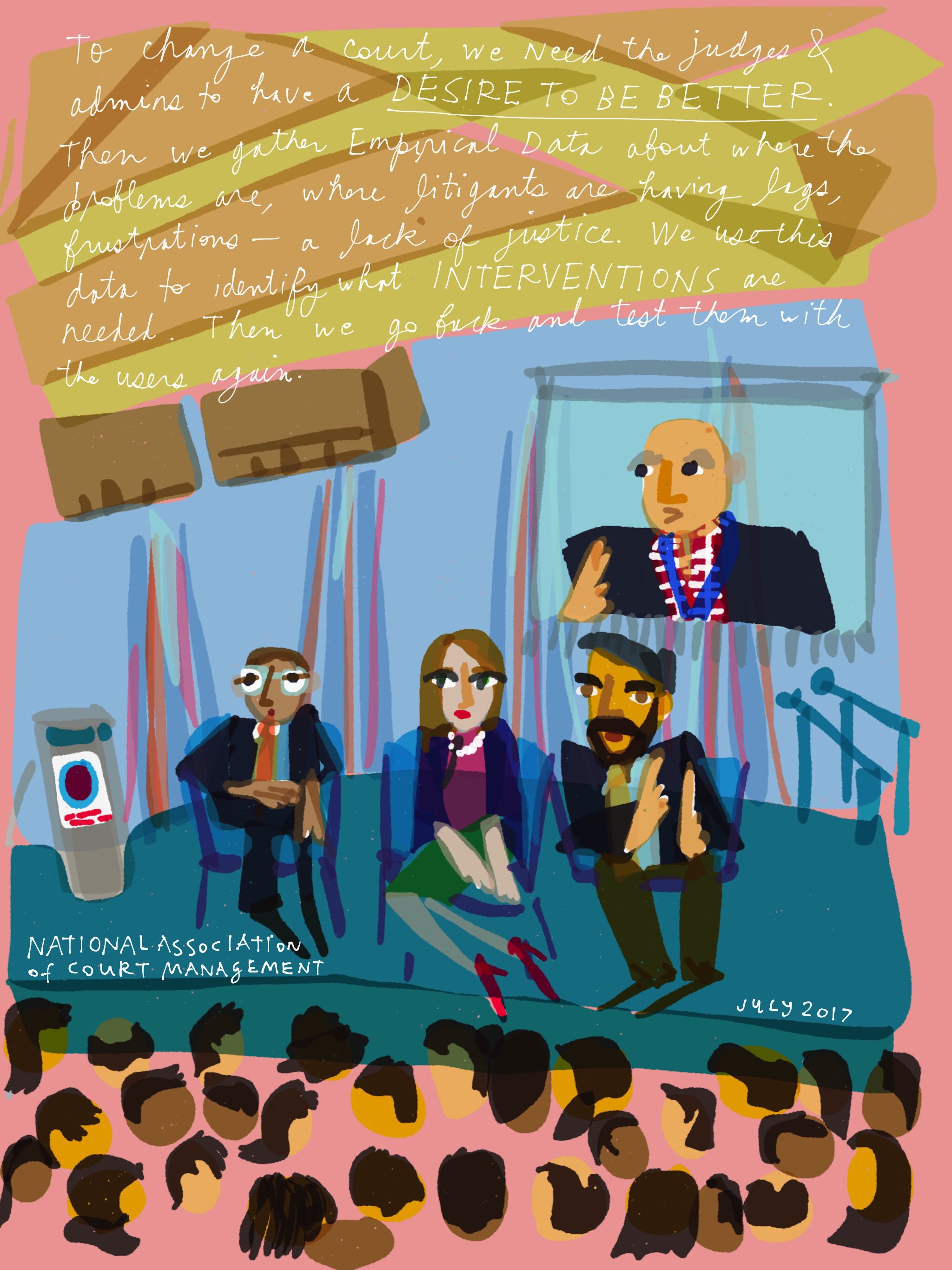
Courts need Empirical Data about their Users
A drawn dispatch from this week’s National Association for Court Management– from the plenary on how we might use evaluative frameworks to improve how courts perform.
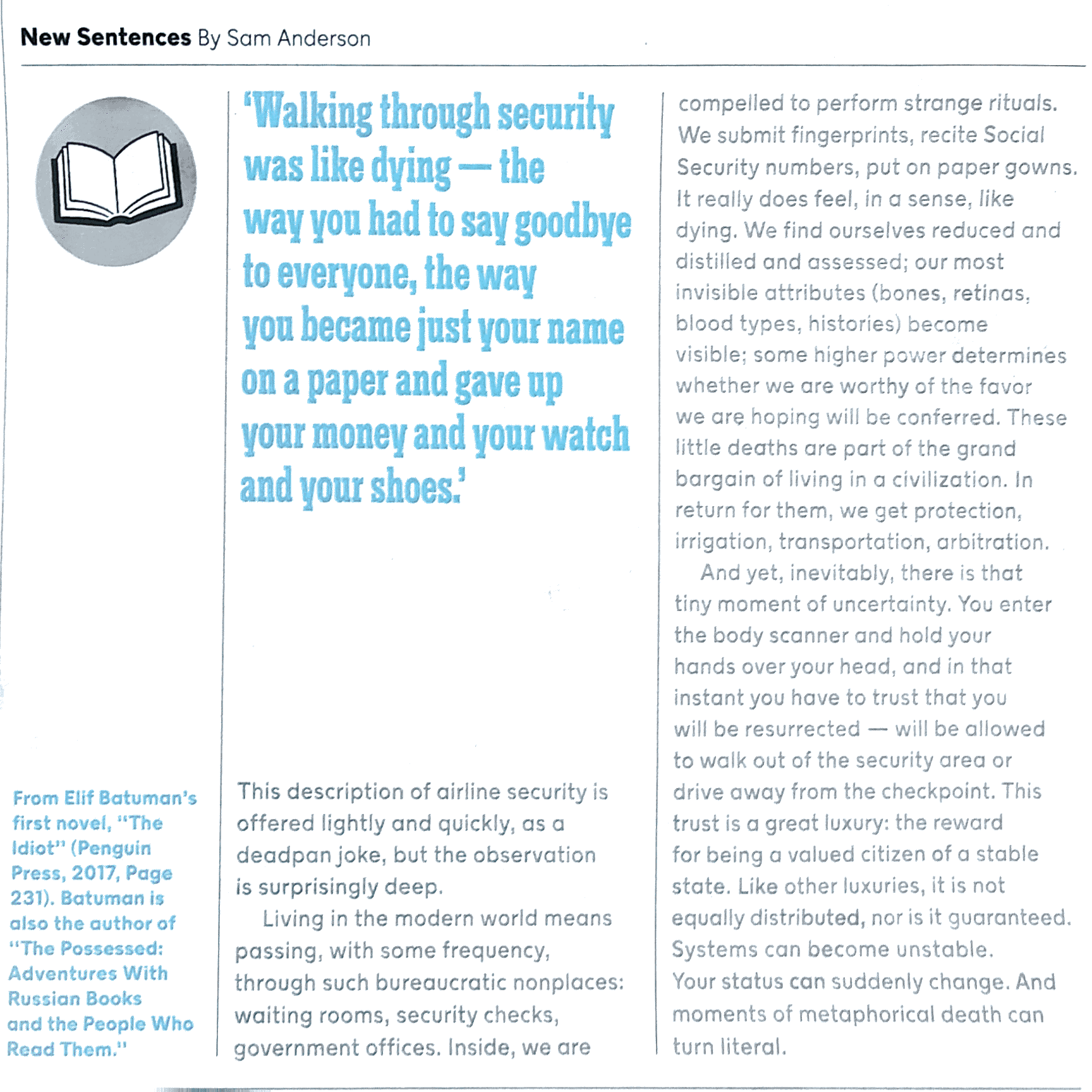
Is the user experience of going into a court building like dying?
Last week’s New York Times Magazine features a beautiful quote and accompanying exploration of what it means to a person in a bureaucratic building. The original quote from Elif Batuman’s (terrific!) 2017 novel The Idiot observed how going through…
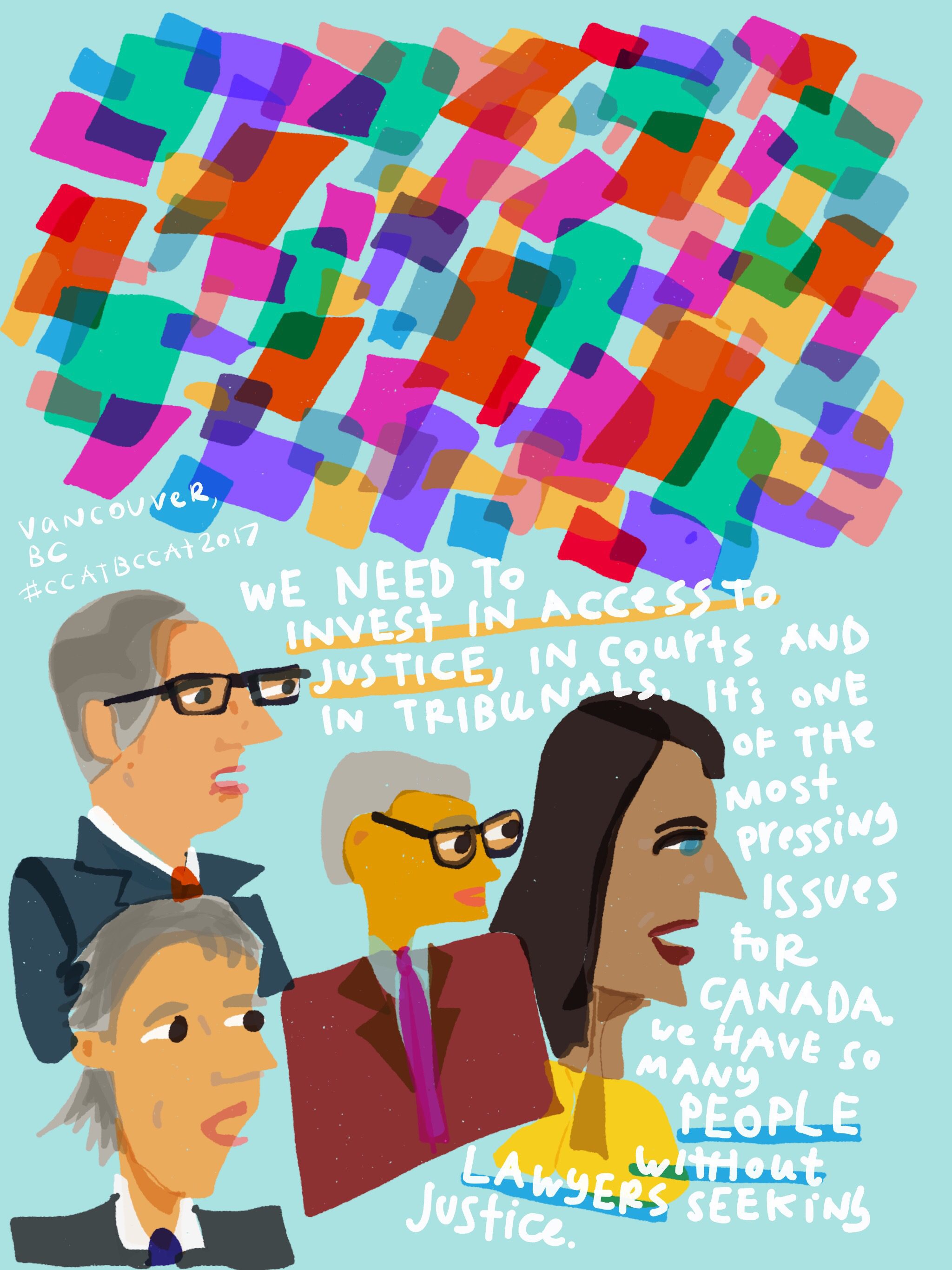
Access to Justice through User Experience and Experimentation
Today I am in sunny, lovely Vancouver, British Columbia at a symposium of the Canadian Administrative Tribunals’ adjudicators, advocates, and other professionals. It’s co-hosted by the Council of Canadian Administrative Tribunals and the British Columbia Council of Administrative Tribunals….
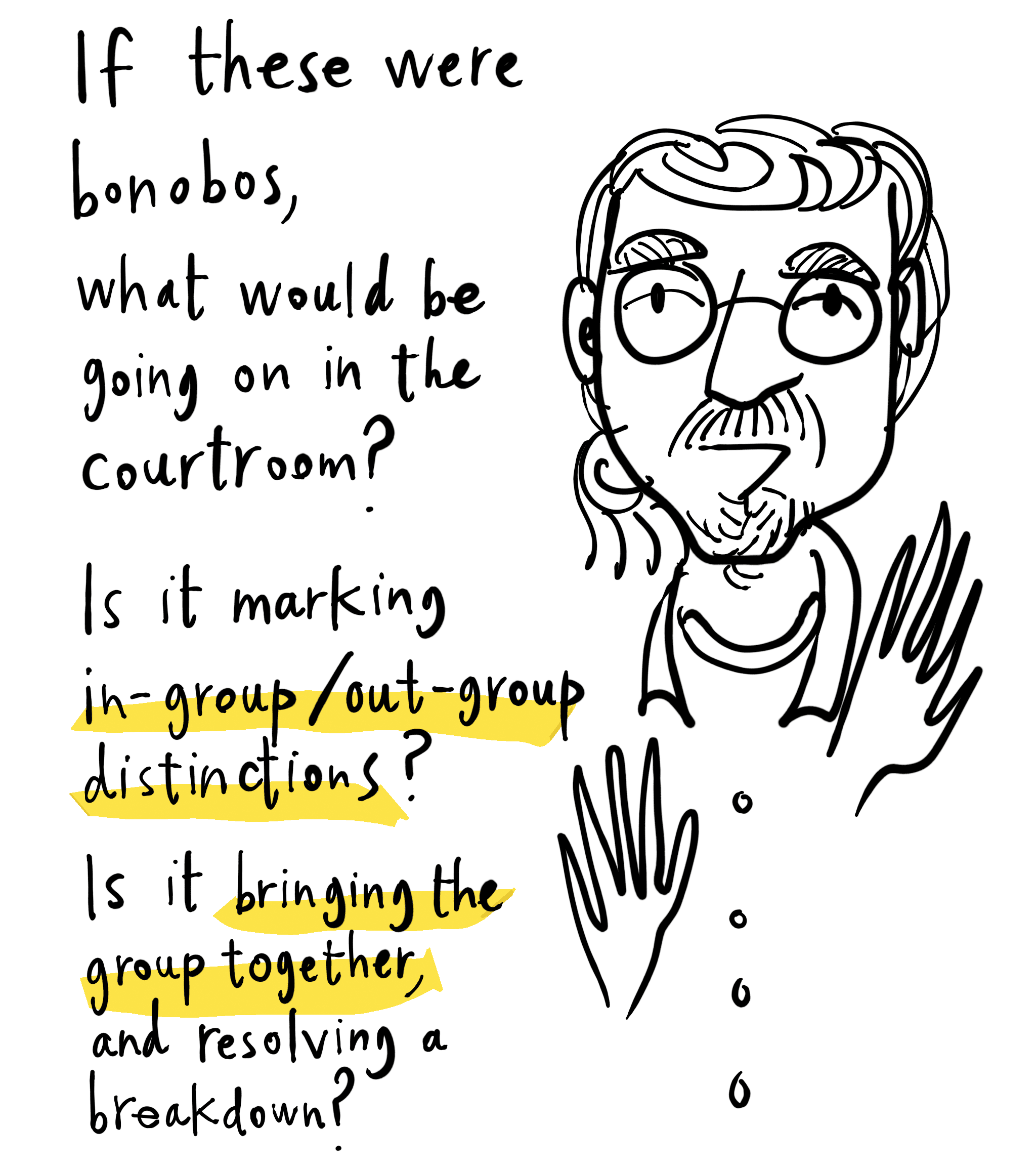
What can legal innovators learn from evolutionary biologists?
Earlier this week, I presented my Design for Justice work to a group at the Gruter Institute, with a mix of lawyers, biologists, computer scientists, economists, and more. It was a wonderful force for analogous thinking — because the…
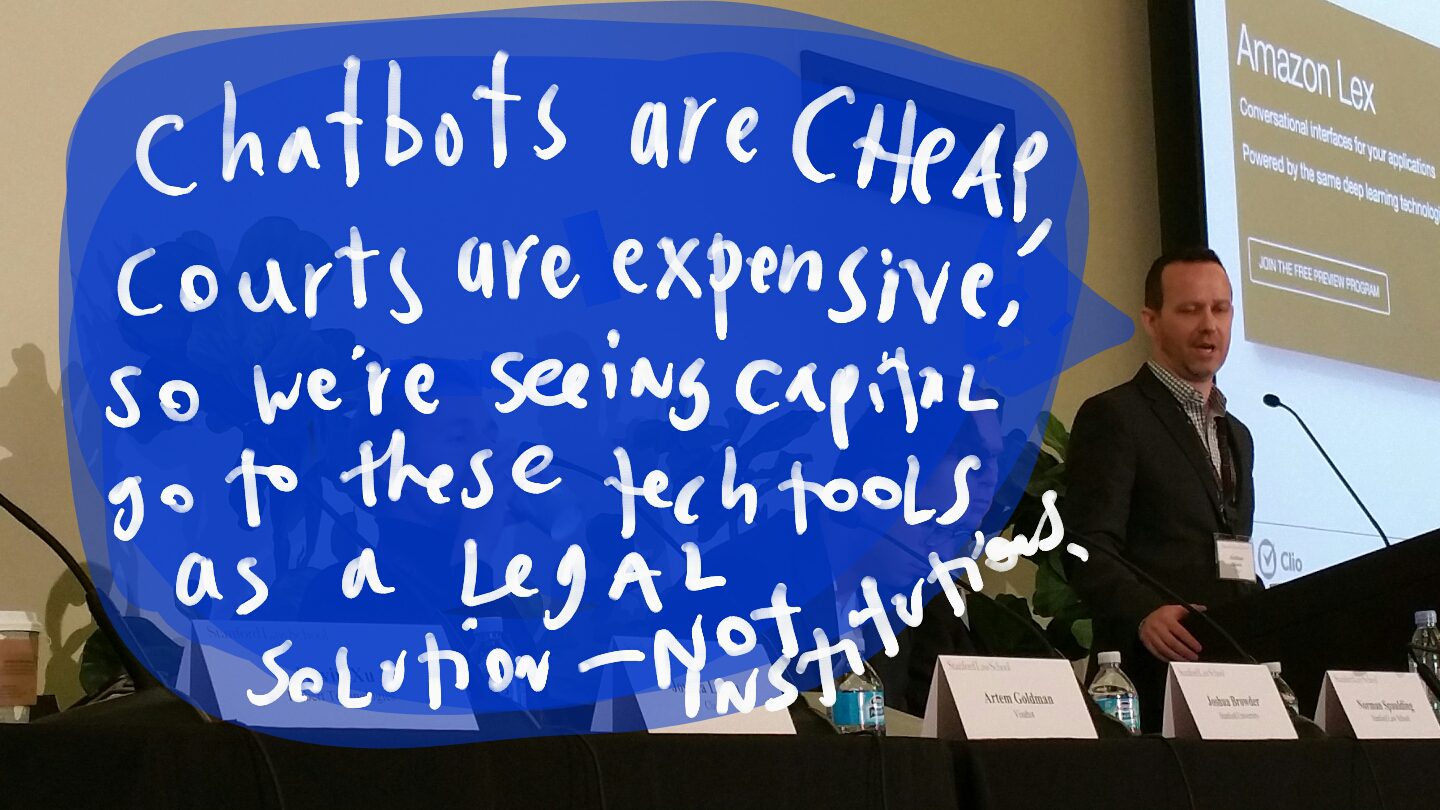
Chatbots might be bringing low quality justice soon #futurelaw
Joshua Lennon lays out an argument for wariness of the coming rise of law chat bots. – they often are not jurisdiction based – they may give people false confidence in quality of the advice – they are too…
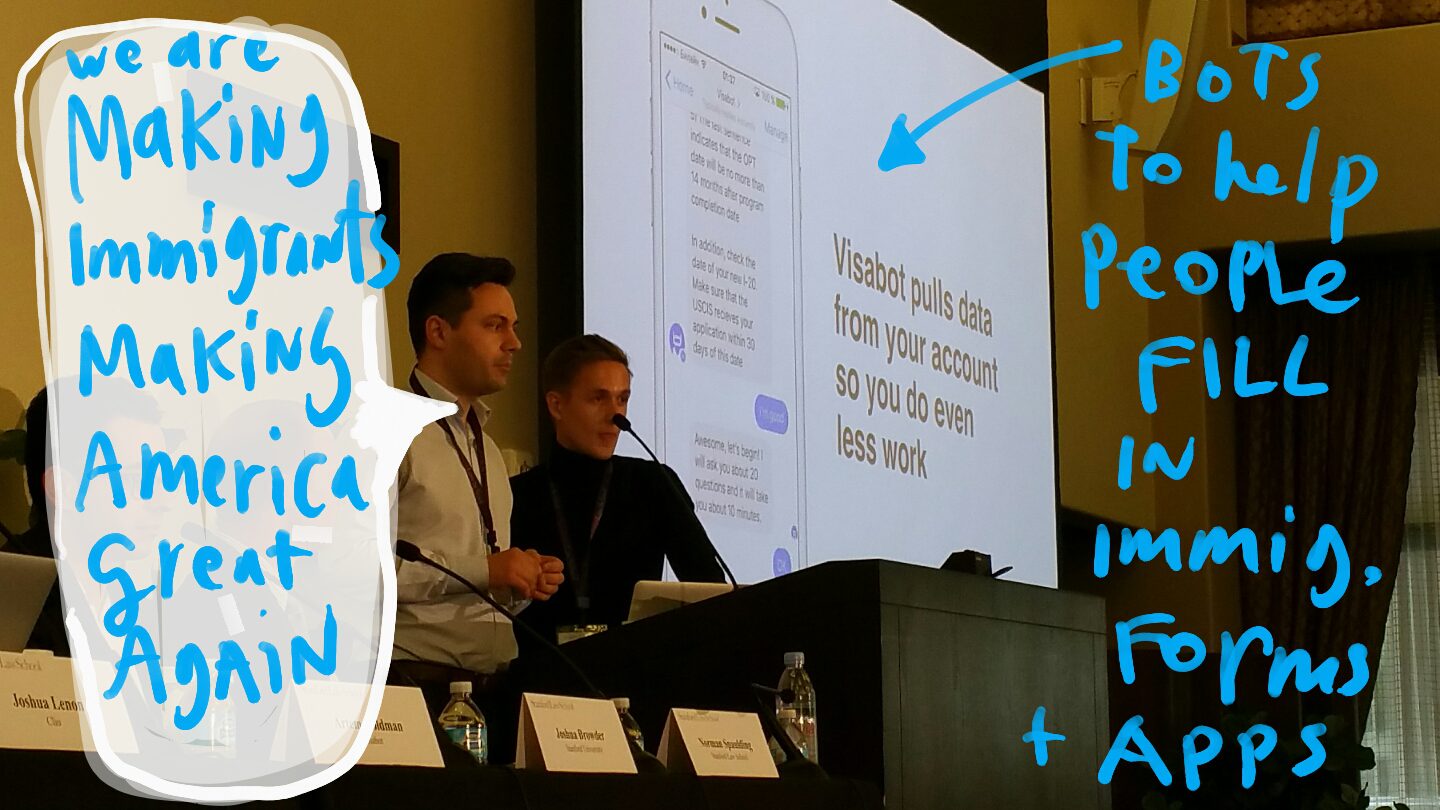
Visabot builds immigration applications over Facebook #futurelaw
Andrey Zinoviev and Artem Goldman have built a Facebook bot — VisaBot — to help people figure out their eligibility for different immigration paths and then complete forms, letters, and other application matters.
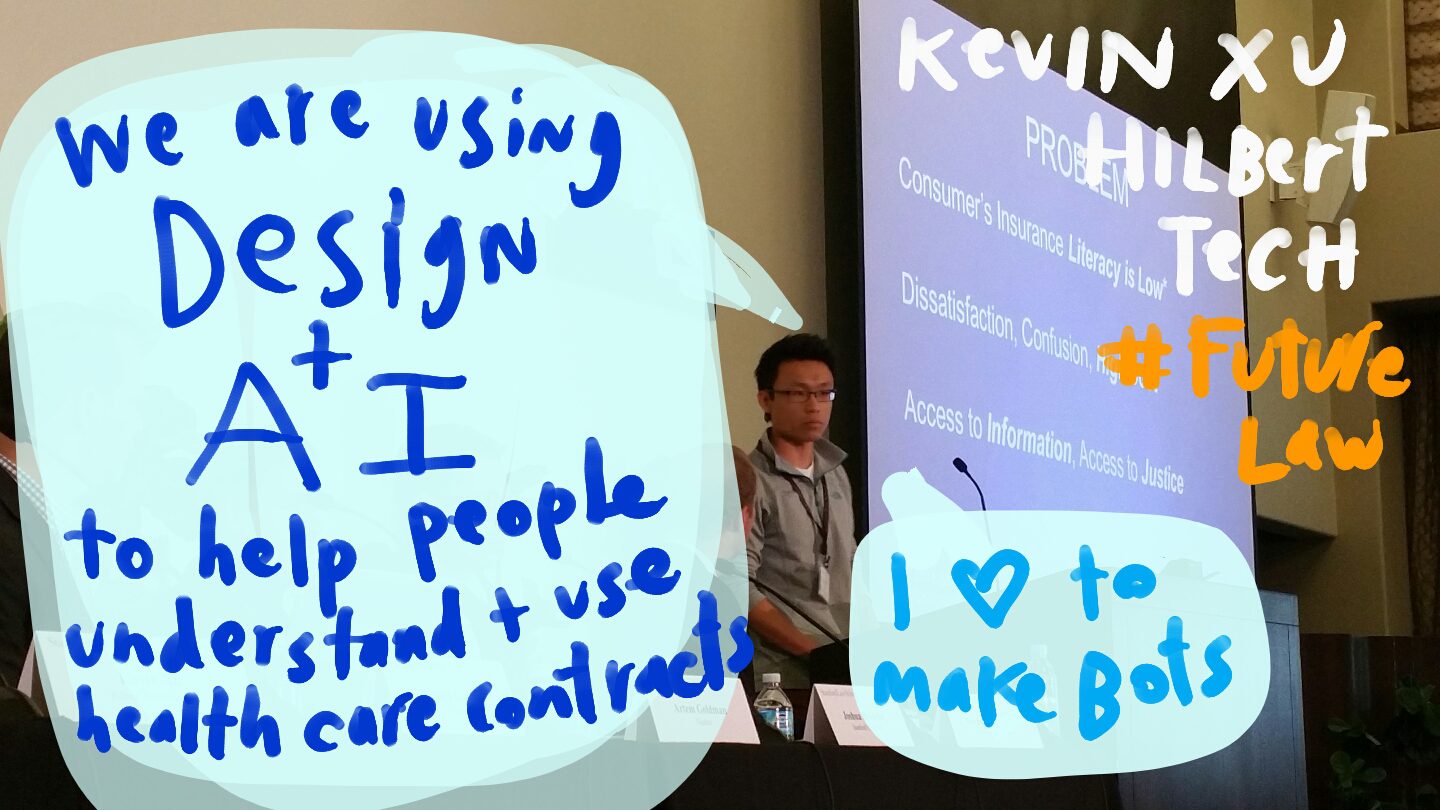
Hilbert bot, helping you to navigate your health plan #futurelaw
Stanford law student Kevin Xu and his team has made a bot, Hilbert, to help people understand and navigate their health insurance plans. They are focusing on young breastfeeding cancer survivors as a pilot group. They used design thinking…
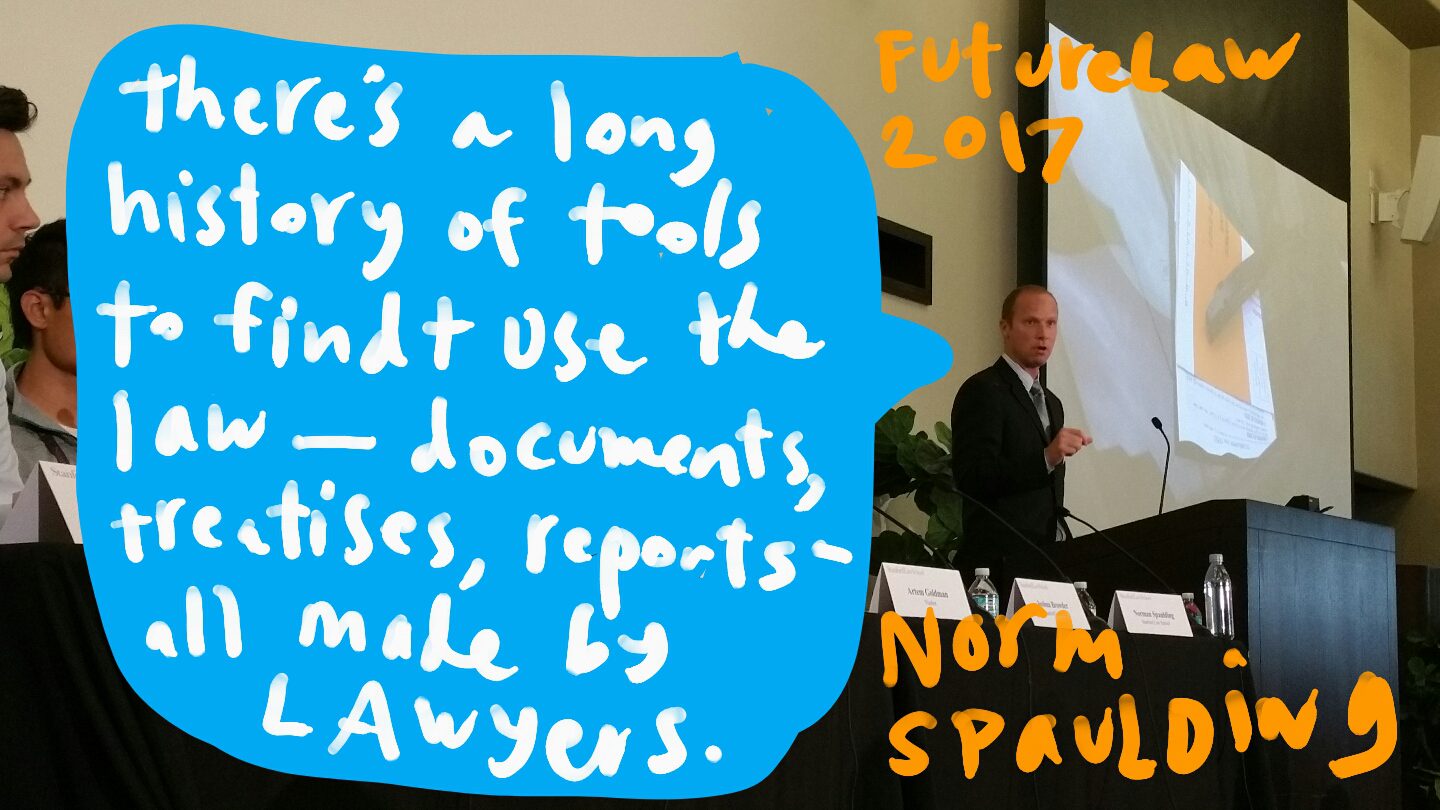
Legal innovation’s paper roots #futurelaw
Radical– a historian at a Futurist panel! Prof. Norman Spaulding explains the populist roots of legal tools, to drive greater public access to what the law is. Before software, the technology was paper-based, gathering info, details, structures — making…
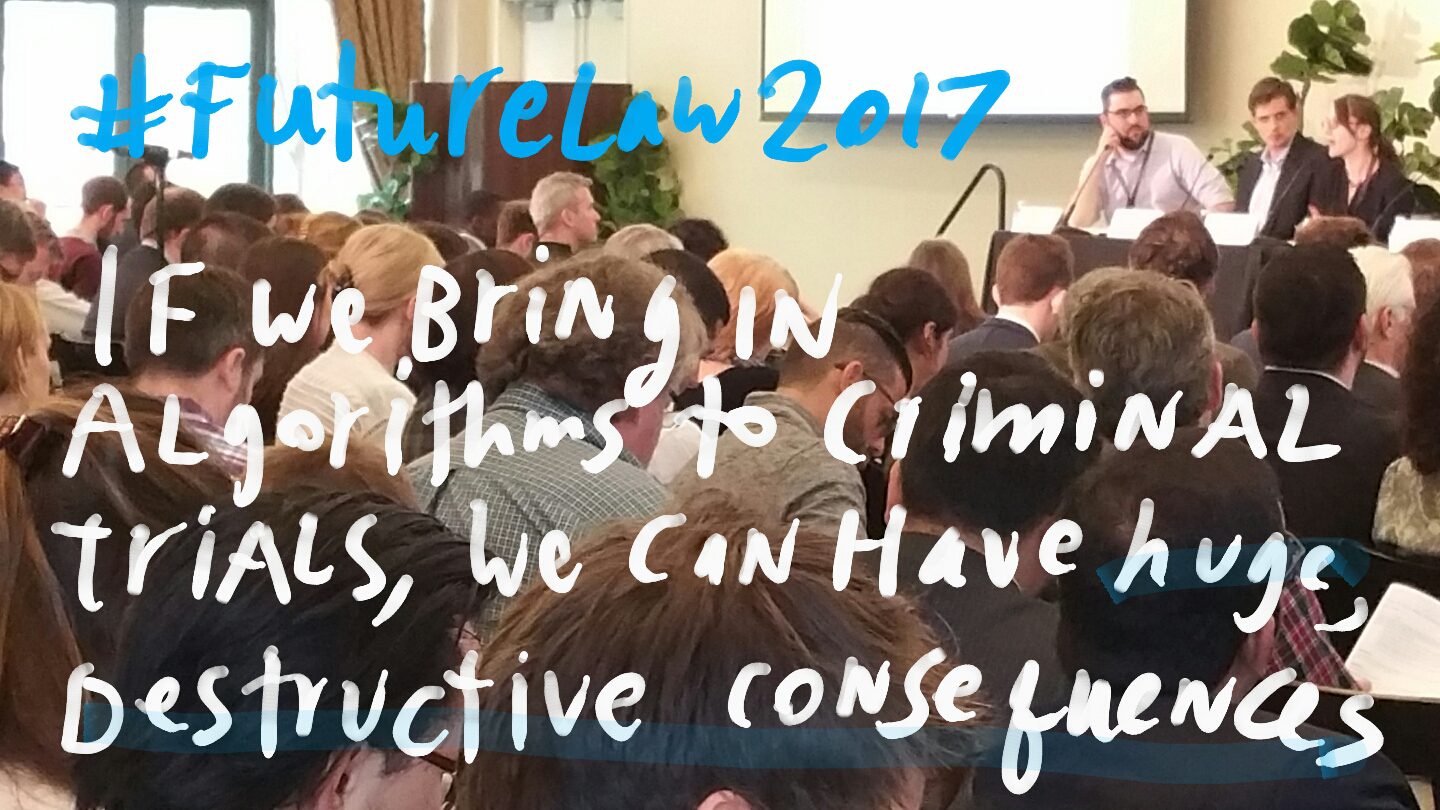
What ethical standards should guide legal algorithms? #futurelaw
We see more discussion of predictive algorithms to judge people in criminal justice, to analyze whether / how to grant probation, bail, etc. But there are serious risks of False Positives, or racist/ biased algorithms. What standards will we…
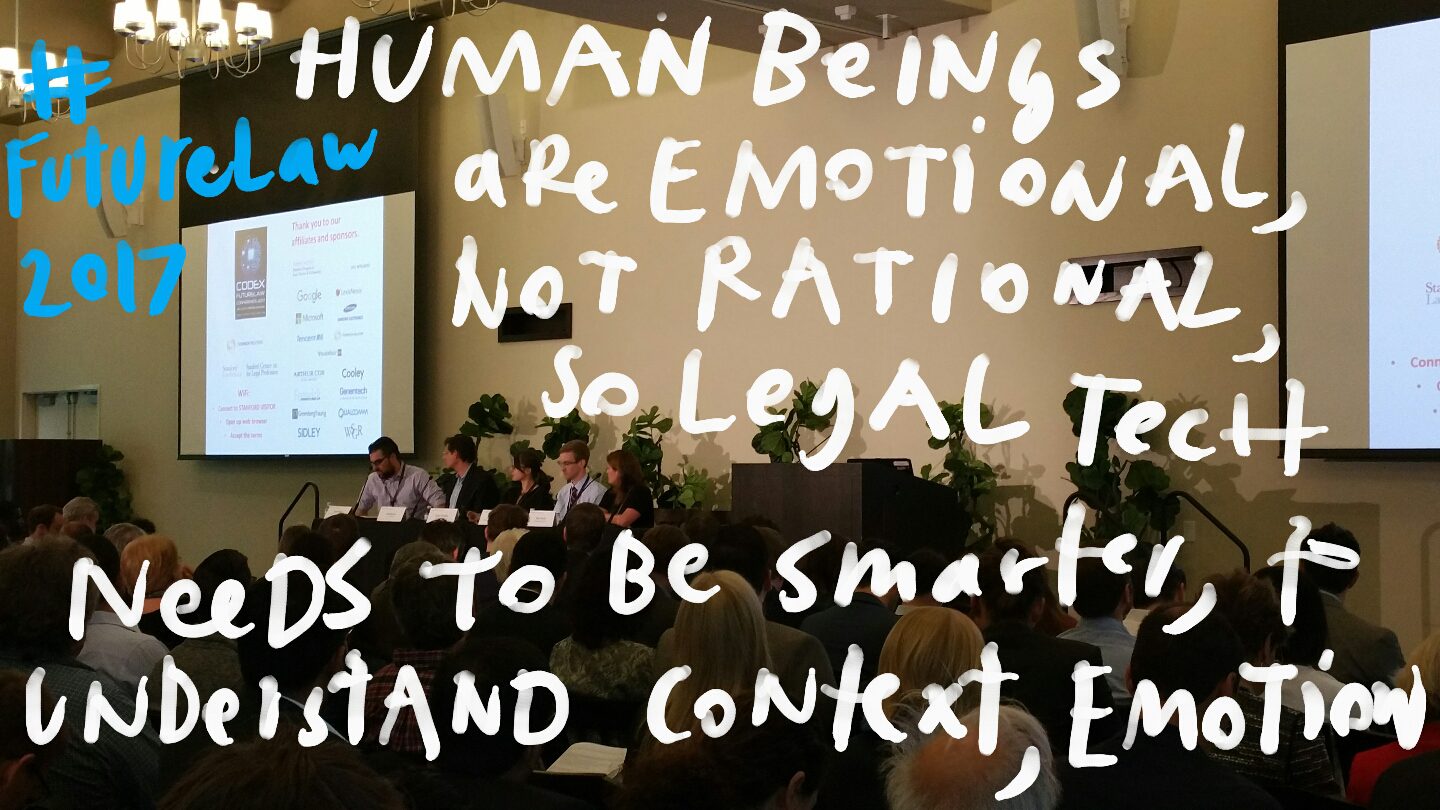
Where are emotionally intelligent legal tools? #futurelaw
A panel on law, algorithms, ethics, and future tech. How do we build tools that understand when a person says, “I want a divorce,” they might be mad & not really want divorce- but counseling. Or, they might be…
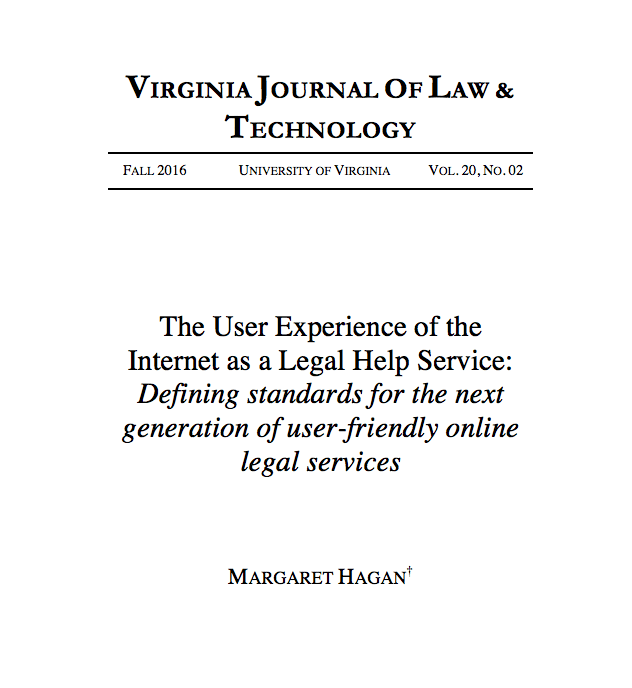
The UX of the Internet for Legal Help: Defining standards for a user-friendly legal internet
One of my academic articles has just been published in the Virginia Journal of Law and Technology. It’s called “The User Experience of the Internet as a Legal Help Service.” The article presents findings from my research into how…
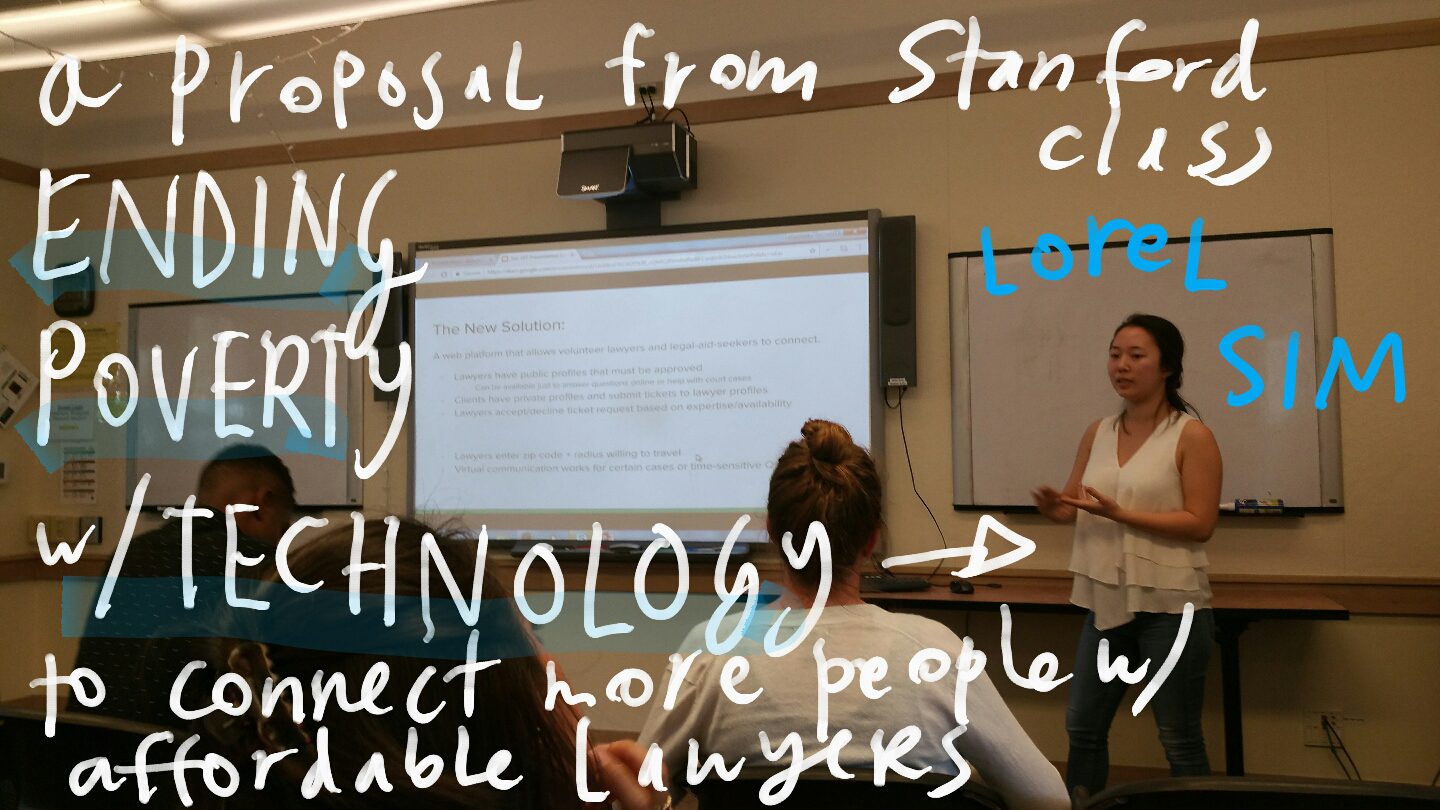
Ending Poverty with Tech + Lawyers
This afternoon I was privileged to attend the final presentations in the new Stanford class Ending Poverty with Technology. This class is taught by Sociology professor David Grusky, in conjunction with the Stanford Center on Poverty & Inequality, of which…
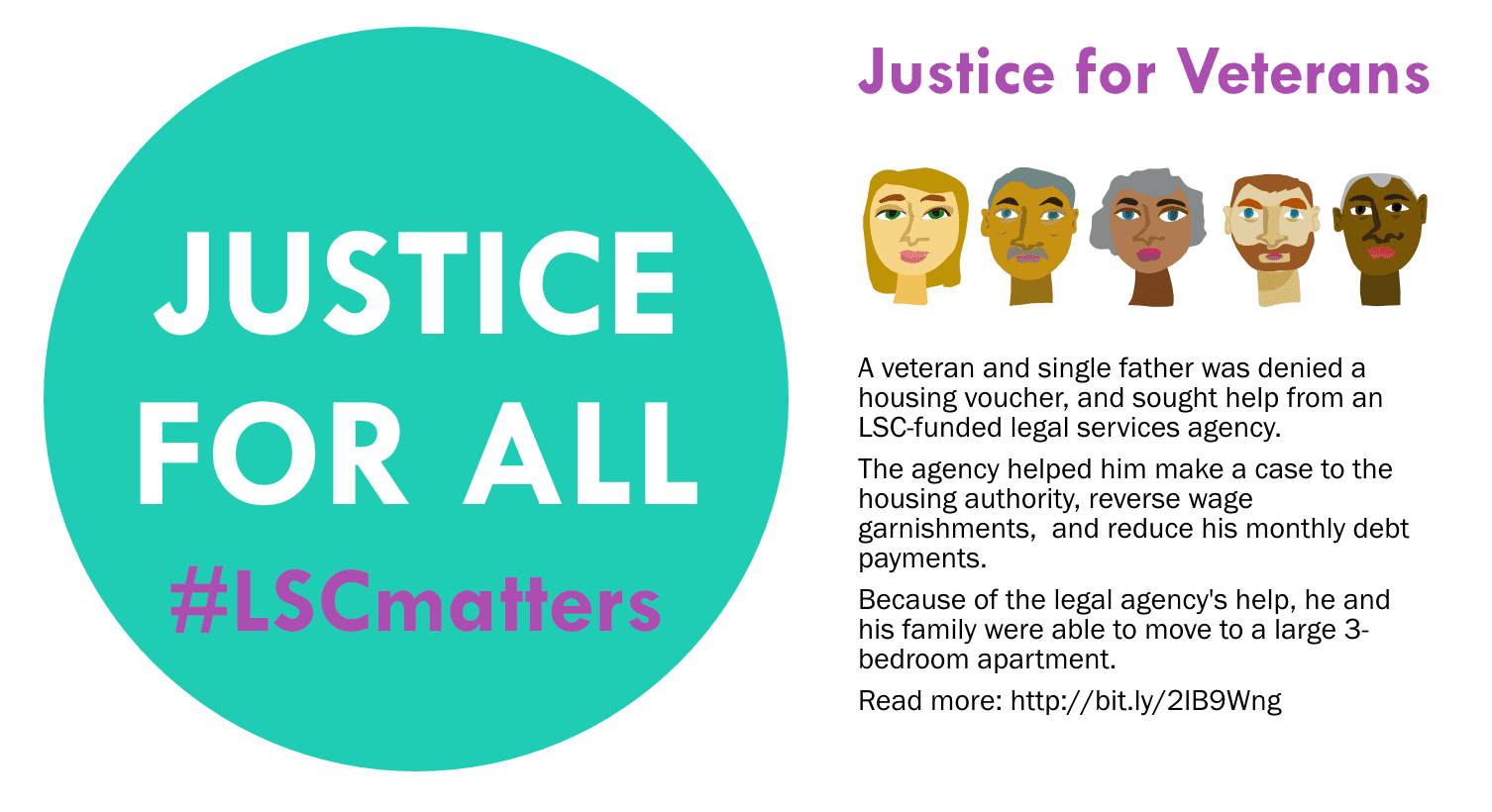
Justice For All: saving the Legal Services Corporation #LSCmatters
The Office of Management and Budget released its proposed budget this week, in which they propose the elimination of the Legal Services Corporation. The LSC is the closest thing we have in the U.S. of a public fund to…
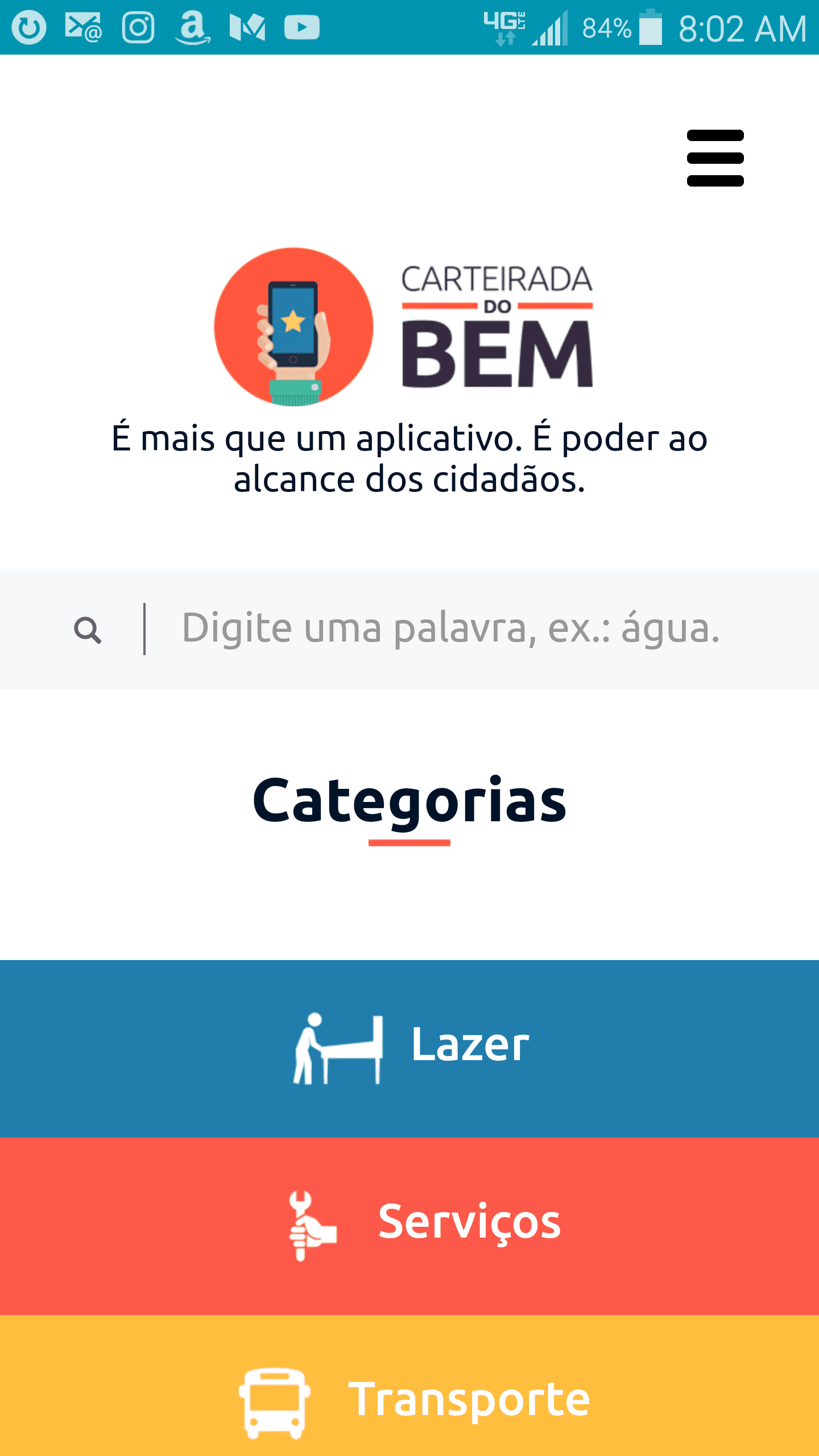
Know Your Rights magic word app from Brazil
One of my Brazilian students in my Prototyping Access to Justice class alerted me to a very cool app in Brazil, all about empowering people about their legal rights. It’s called Carteirada do Bem. It’s a native app (on…
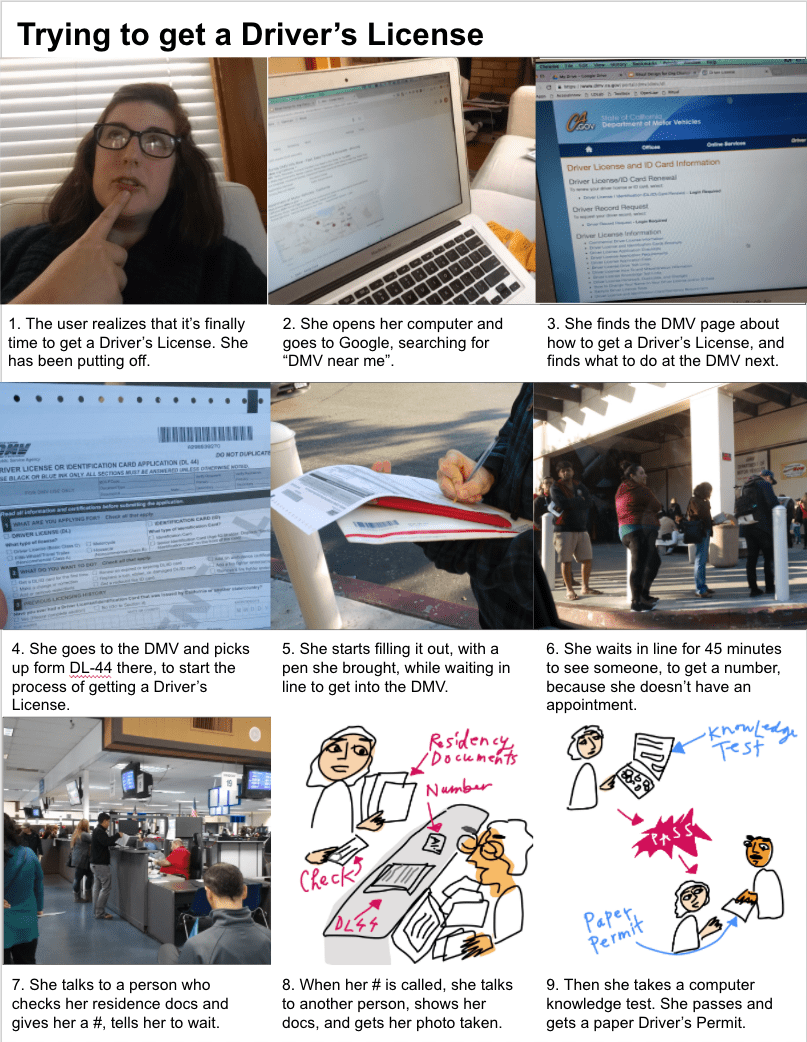
Photo Walkthroughs as legal guides
What are better ways to help people follow a legal process? To get all the tasks, forms, consults, and decisions made to get to resolution? One mode I’ve been experimenting with in my Prototyping Access to Justice class is…
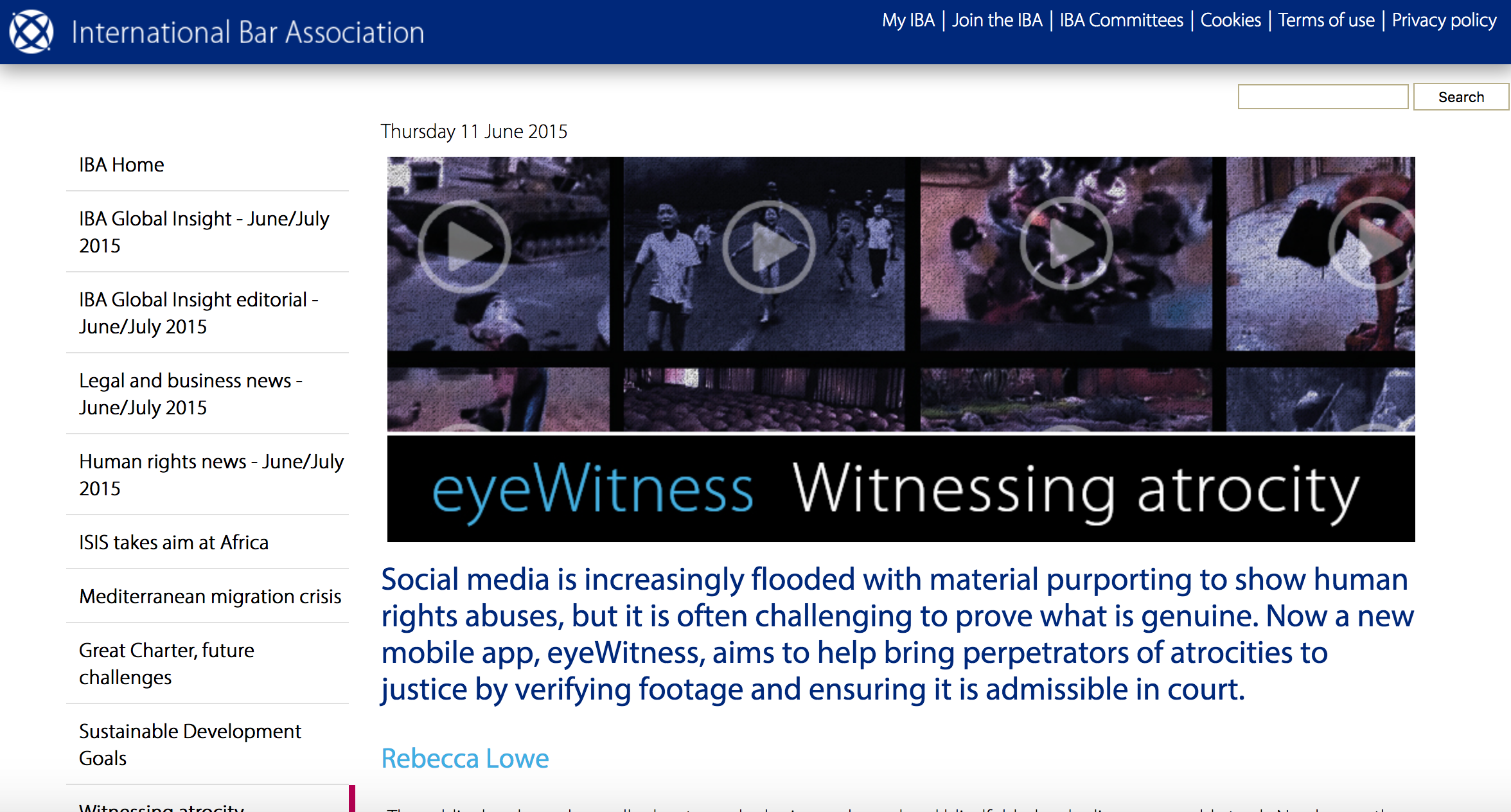
Evidence collection app for human rights abuses, eyeWitness
The International Bar Association has published the app eyeWitness, to allow people on the ground, in situations where atrocities are occurring, to gather evidence. The system they’ve set up also verifies this evidence. The central value is to help…
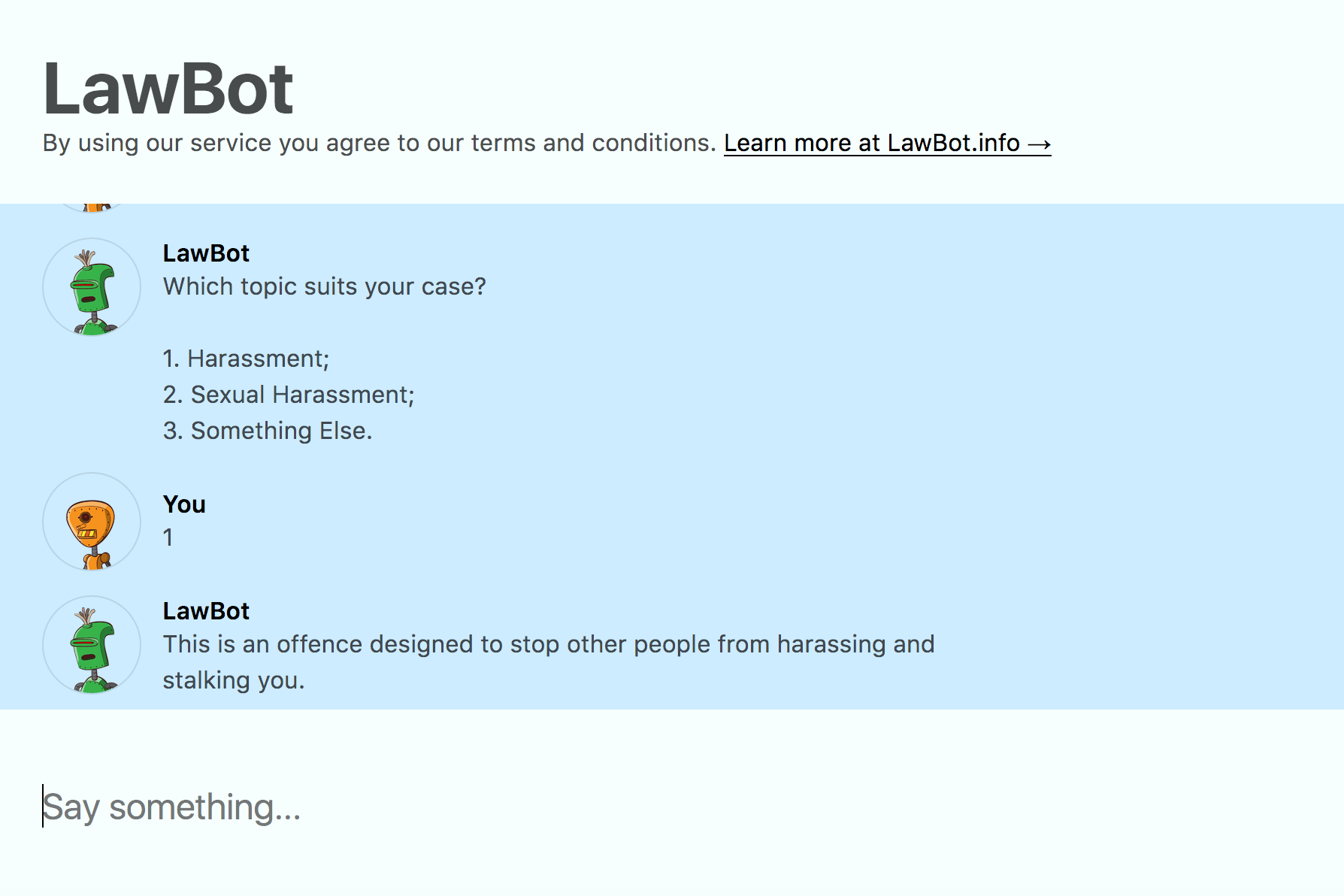
Lawbot as a chatbot lawyer for crim
A team from the University of Cambridge have launched Lawbot (BETA), an interactive conversational tool that can consult people on their possible legal situations. It’s a British tool, covering only criminal offenses in England and Wales. It lets people…
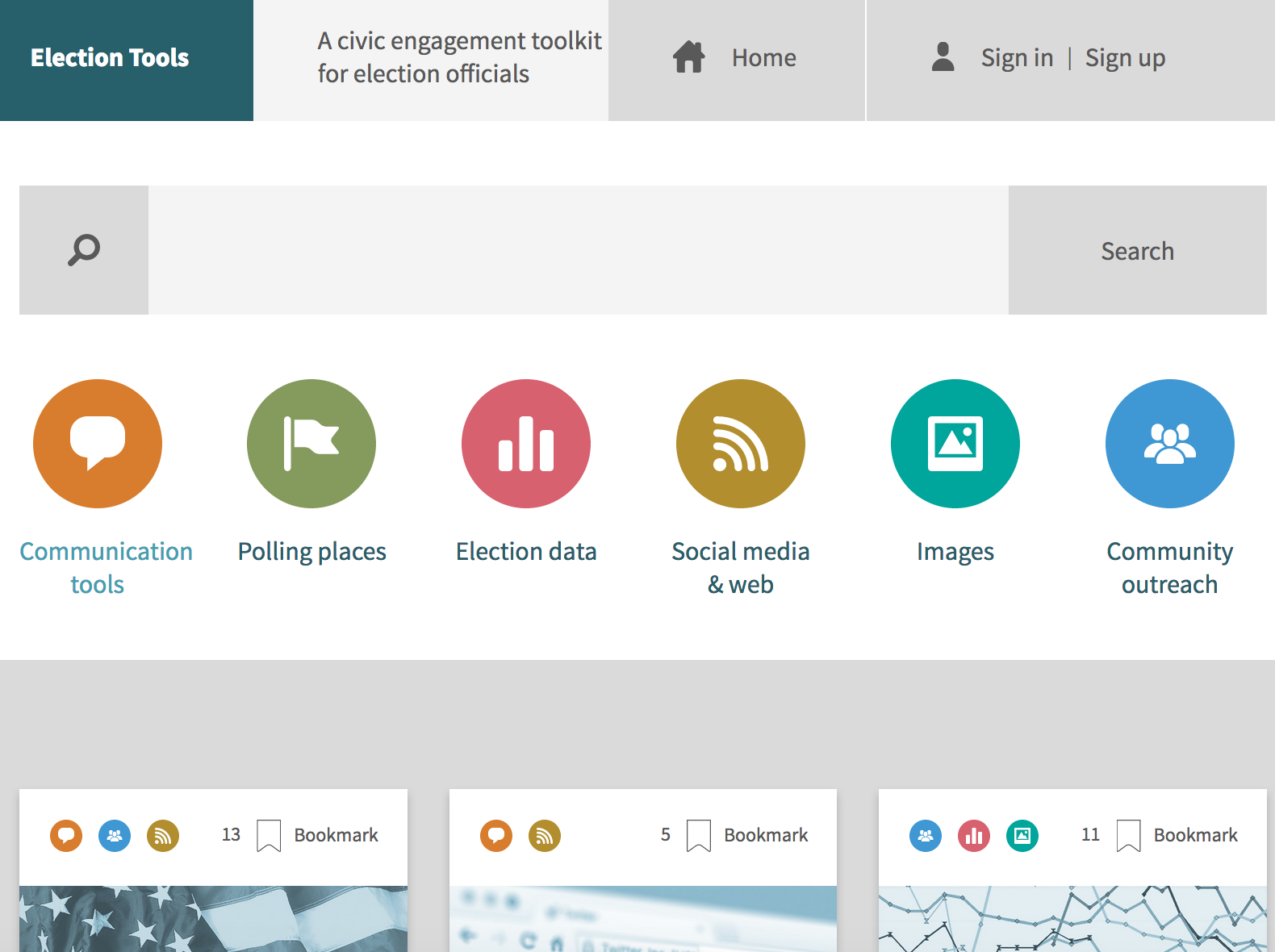
Center for Civic Design and usable elections
Thanks to Aaron Stienstra for linking me to the Center for Civic Design, an effort to bring good design to elections and ballots. They are a non-profit who take information design, usability, and plain language to the cause of…
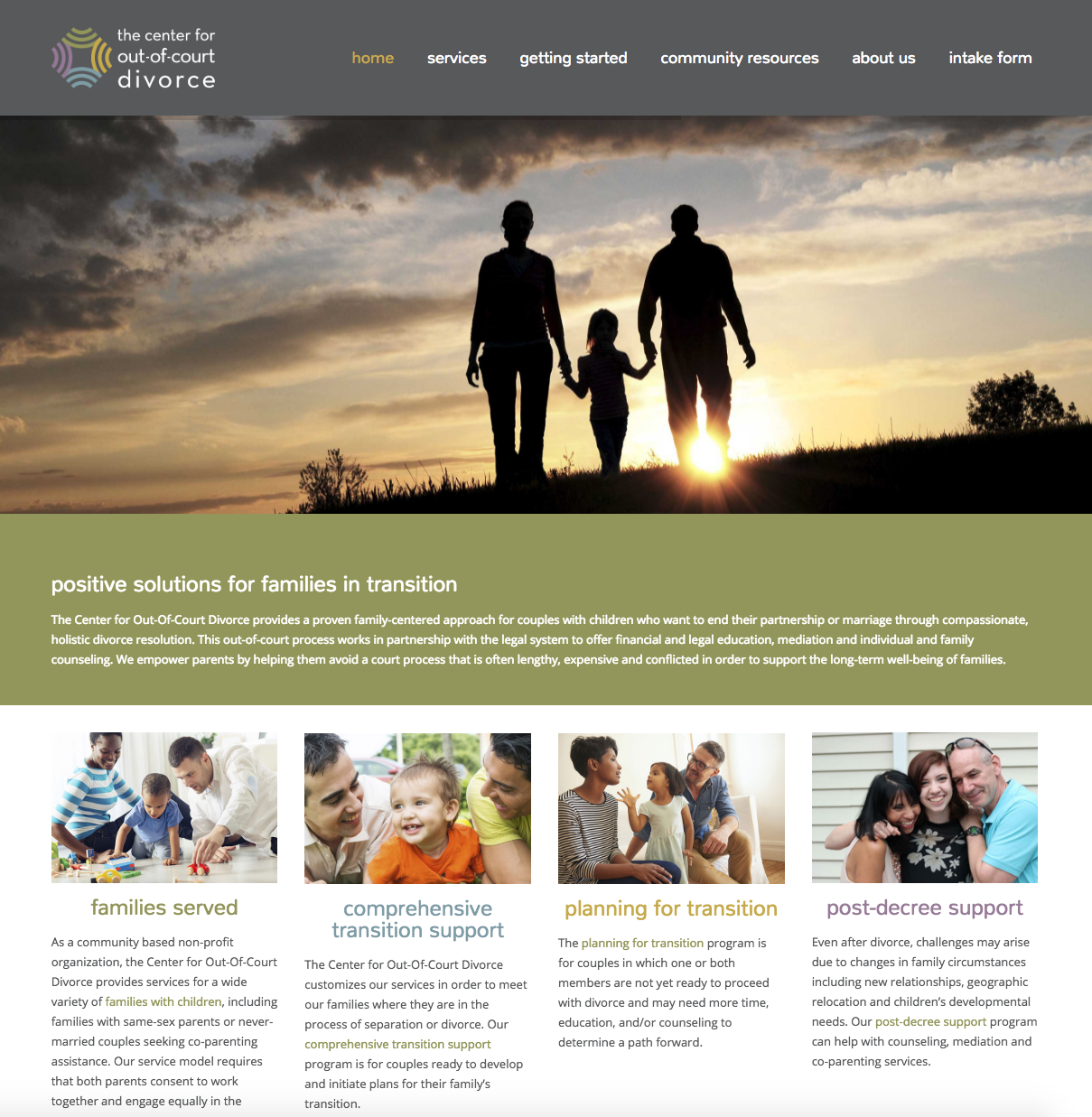
Collaborative legal services with the Center of Out of Court Divorce
During a recent visit to the University of Denver, I was so impressed to hear about a project that has come out of IAALS (the Institute for the Advancement of the American Legal System). It’s user-centered, collaborative, and coordinated…
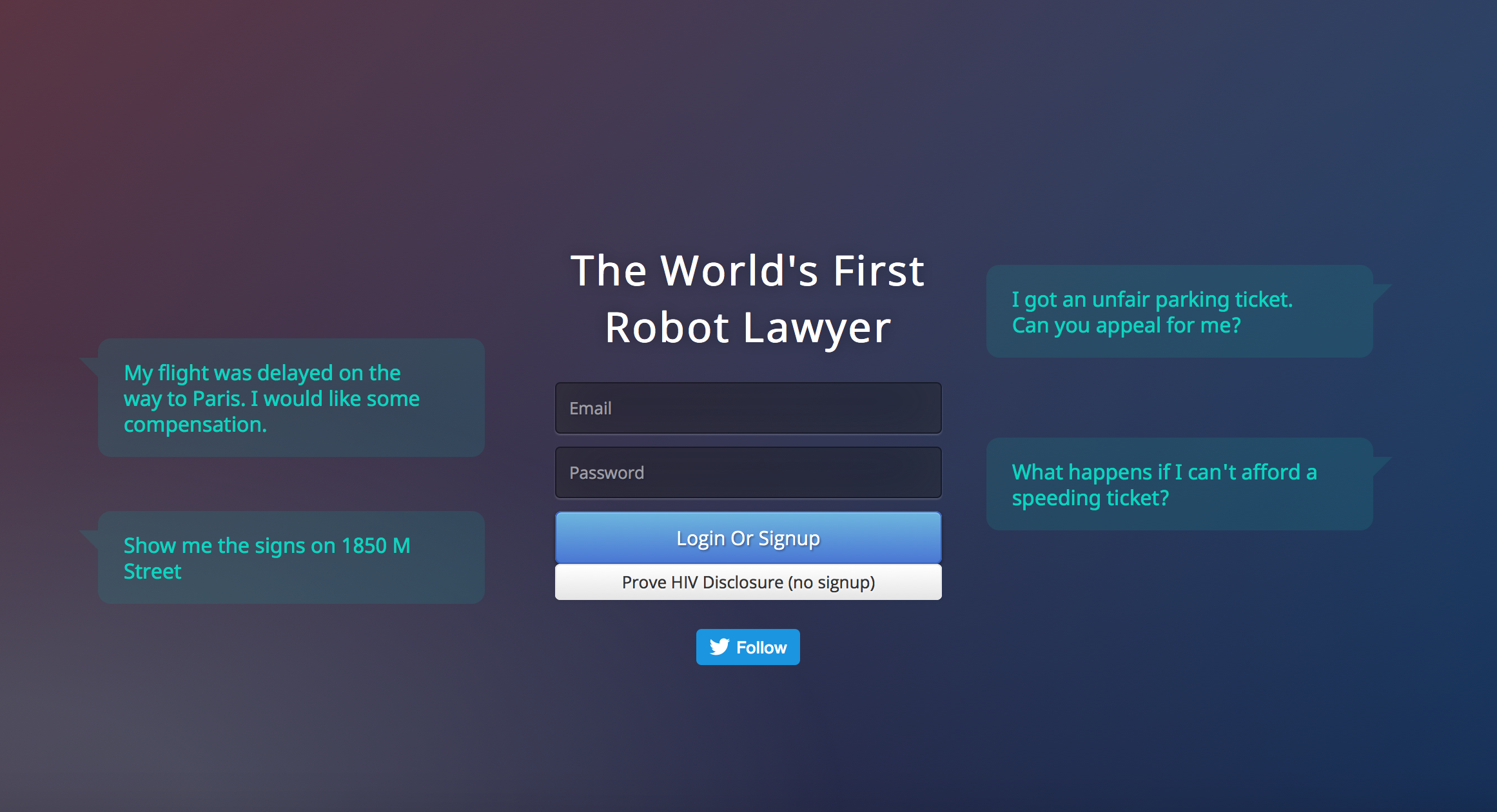
The Bots Are Coming! (to legal services…)
Last week, it was great to see a short article making the rounds about a new chat-bot legal service coded and launched by a Stanford undergrad student, Joshua Browder. It’s DoNotPay, a bot that asks the user questions and…
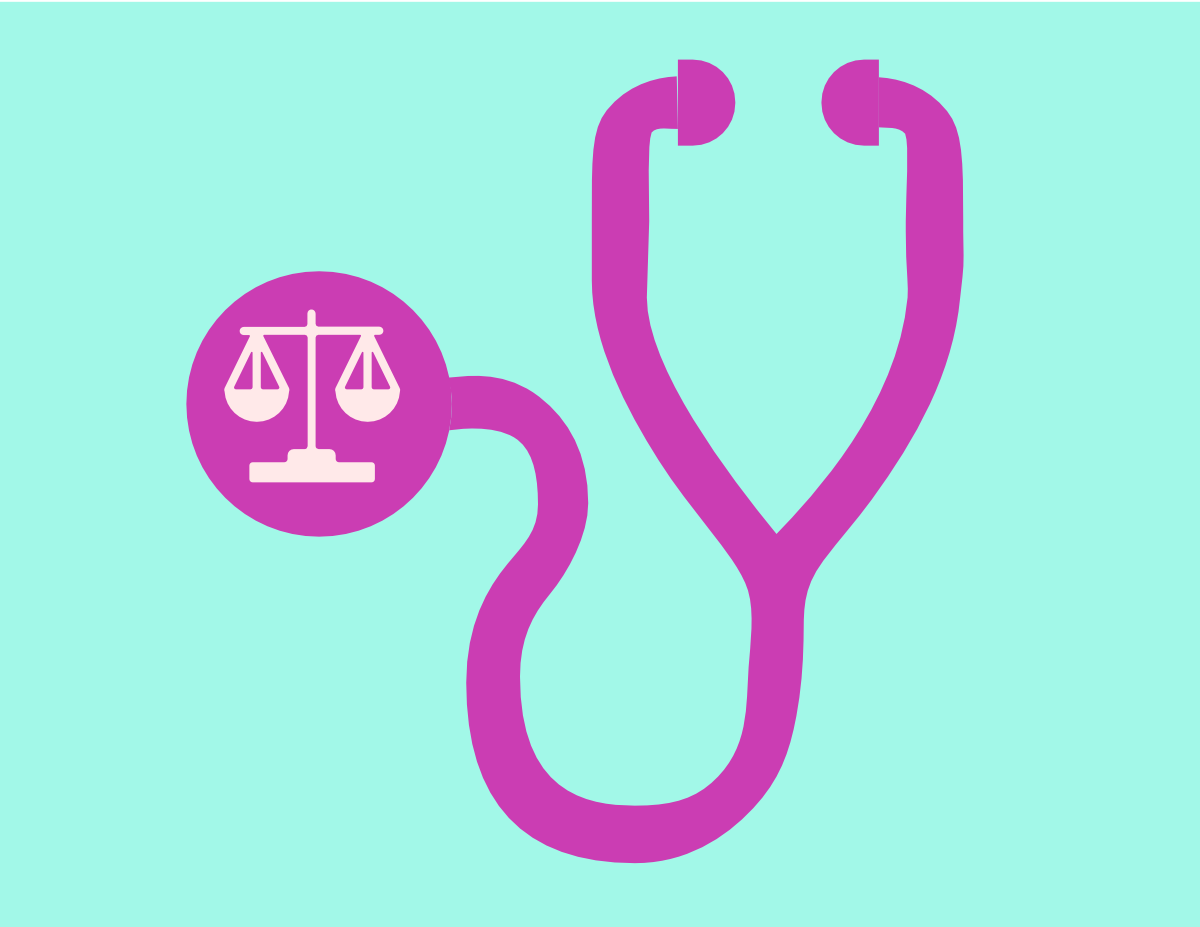
What would an effective, useful Legal Health Checkup look like?
I have been in different working groups and conferences over the past year, all focused on access to justice innovation, and we keep coming back to one new product idea: the Legal Health Checkup. This seems to emerge out…
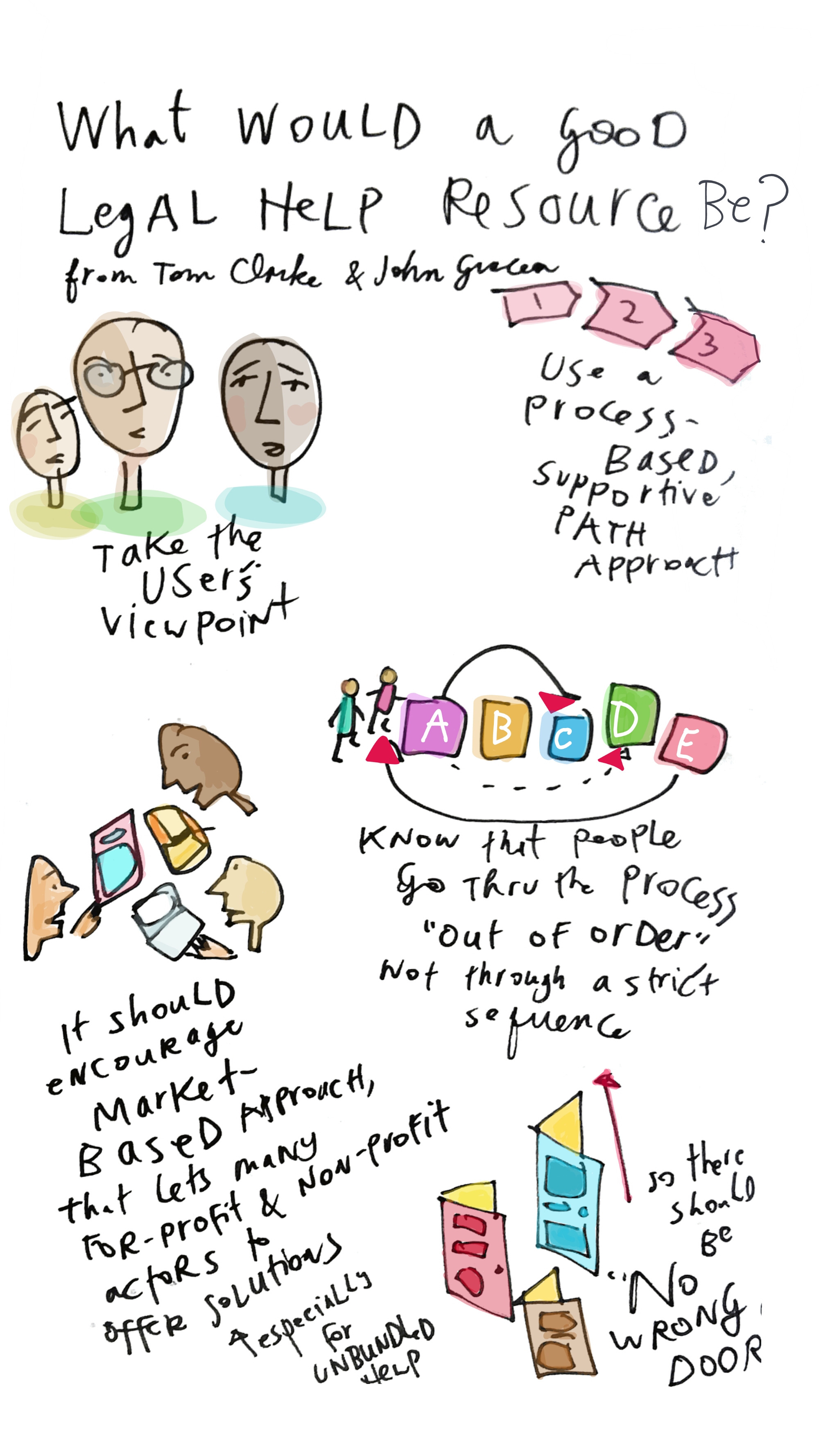
What would a good online legal help resource look like?
If we were to build a 2016 tool to help people, searching online for help with a life problem (that we know has a possible legal solution/redress), what would that look like? What are some of the key features…
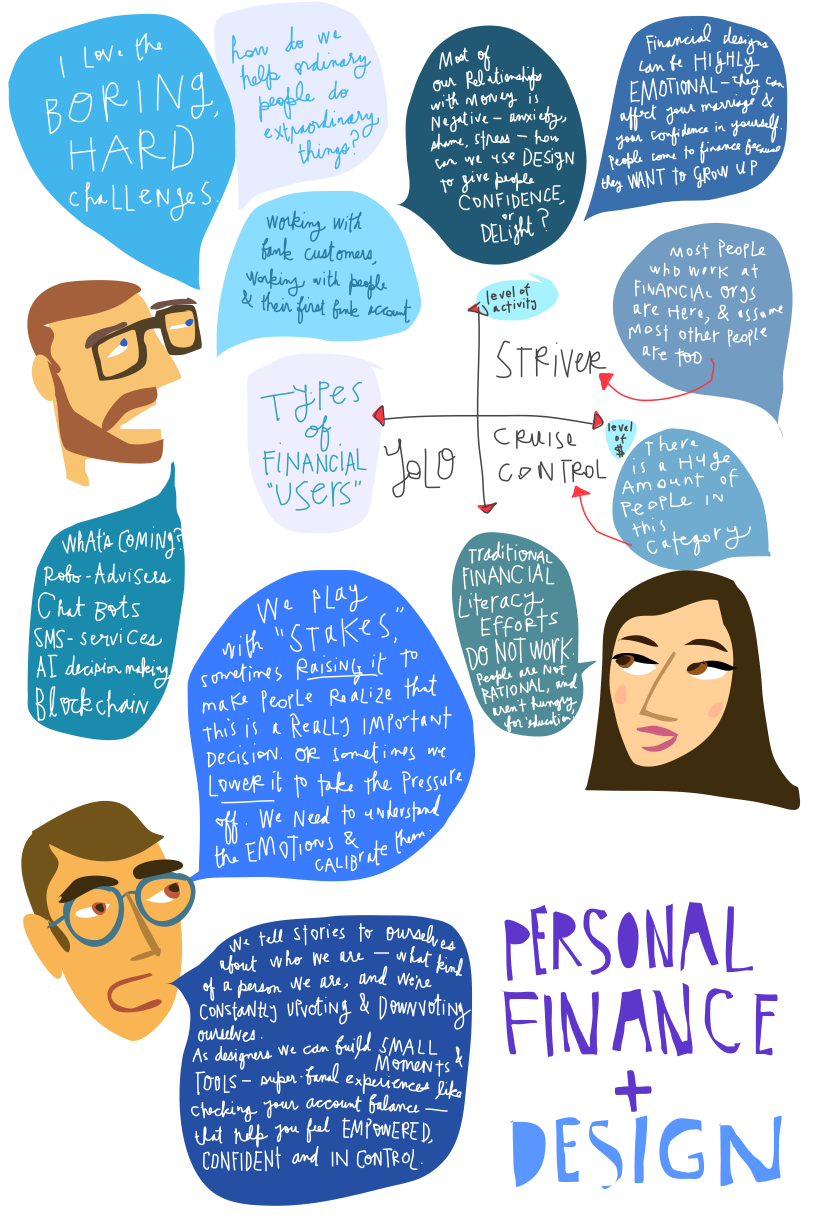
Lessons from Personal Finance Design for Legal Design
Last week I went to an evening talk at Intuit, hearing from a collection of designers, technologists, and strategists working to make personal finance more engaging for laypeople. The panel was moderated by Leslie Witt (Design director of Intuit…
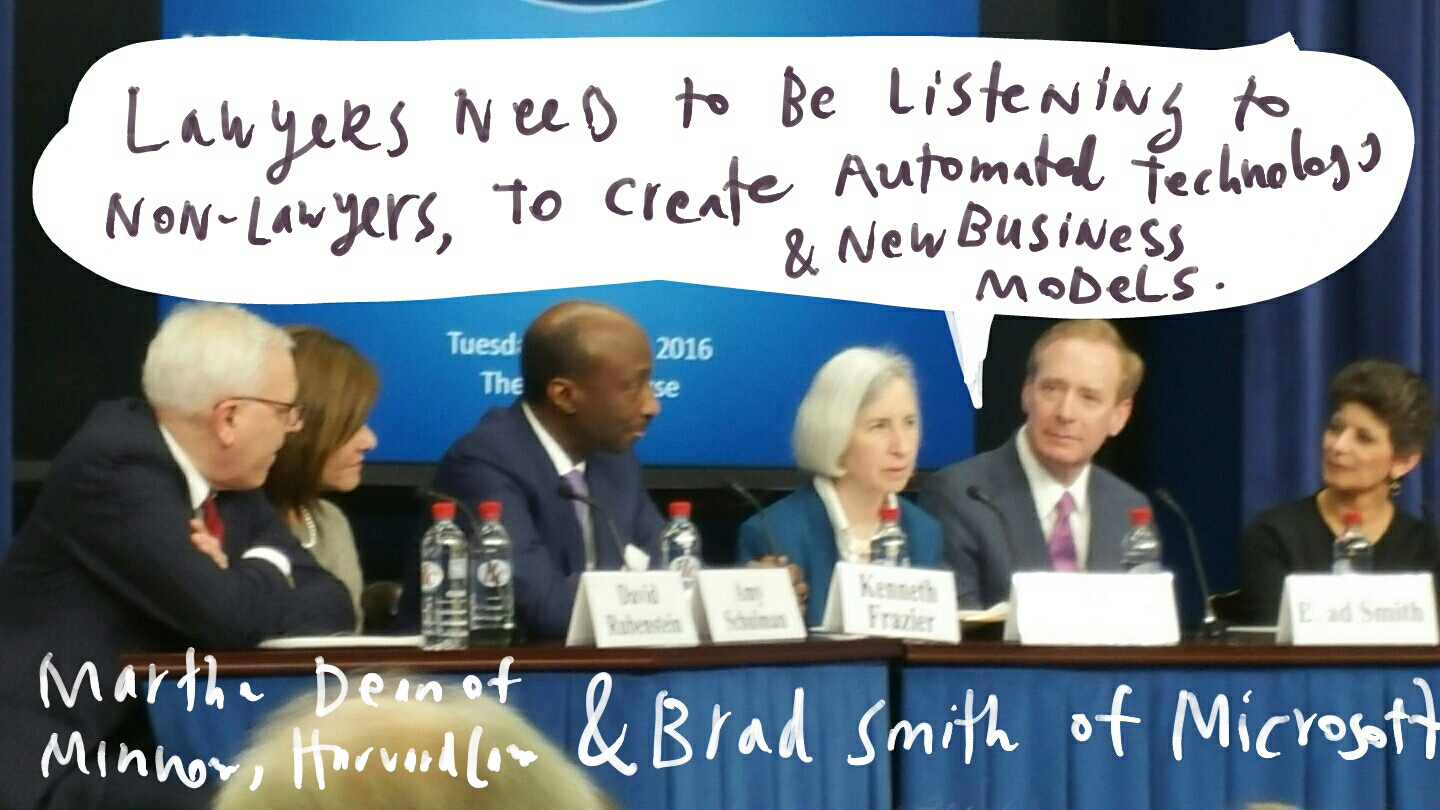
White House Access to Justice forum
Last week I had the pleasure of attending the White House Forum on Increasing Access to Justice. It was a gathering of lawyers, judges, law clinic leaders, business-people, and politicians to talk about both the pressing needs for greater…
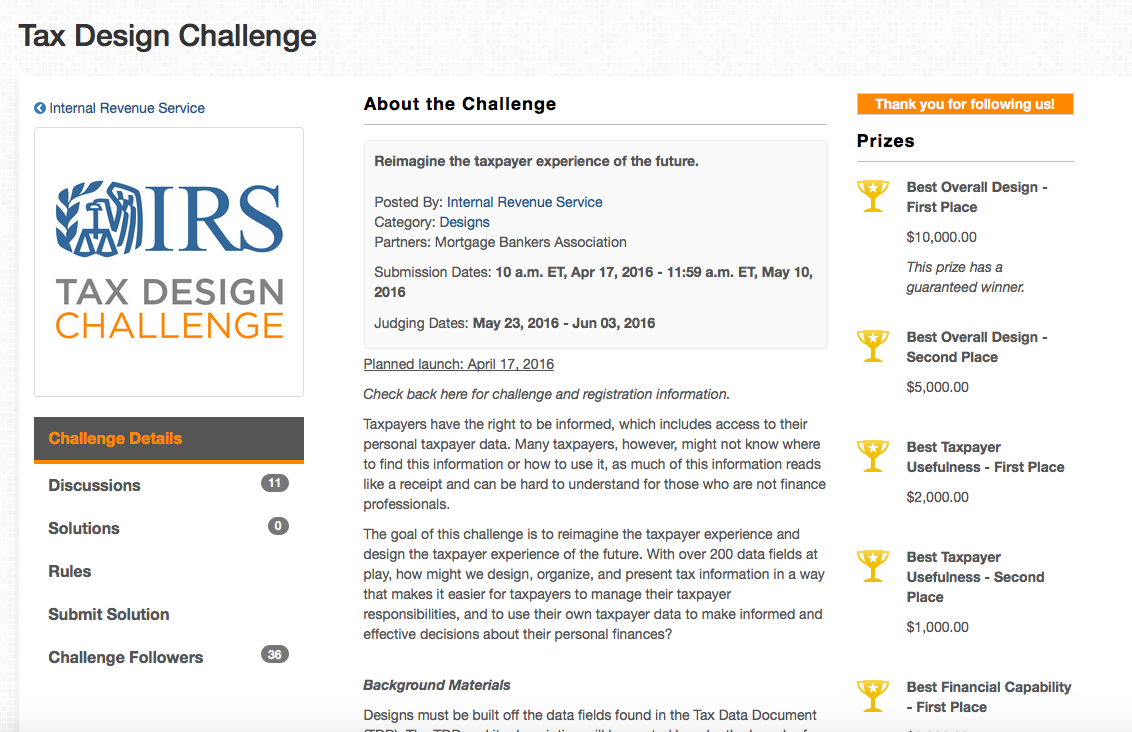
The IRS’ Tax Design Challenge: Rethinking the (miserable) UX of paying your taxes
I realize that I am outing myself as a full-on dork with this post, but I am unreasonably excited by coming across the IRS’ Tax Design Challenge — an open call for new ideas about to how make the…
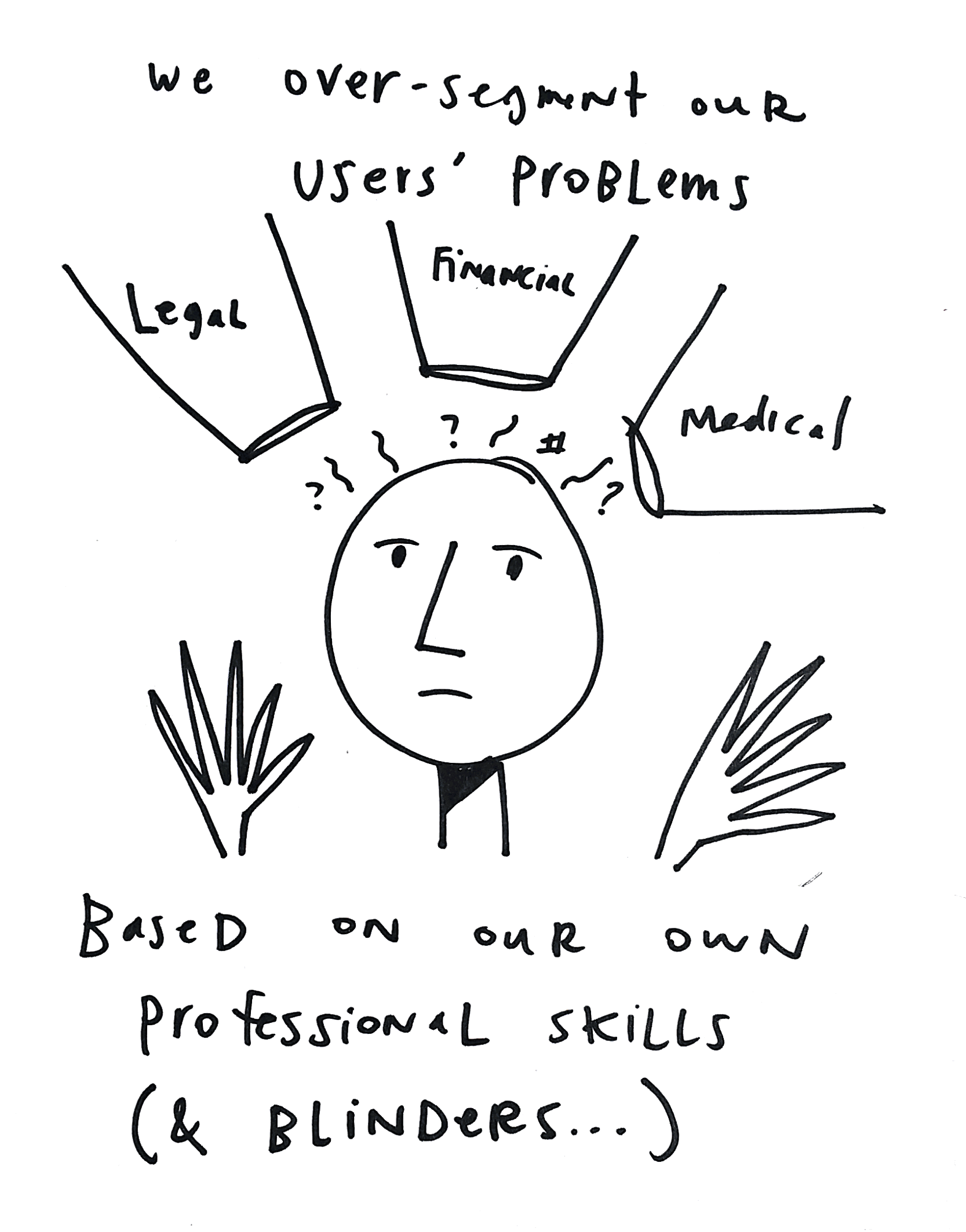
Design for Bureaucracies: envisioning user-centered medical-legal-health care
Earlier this week I found myself at lunch with an expert in sustainable finance, another expert on healthcare and patient engagement, and a user experience designer. Then there’s me — a lawyer and designer working on redesigning the legal system. We…
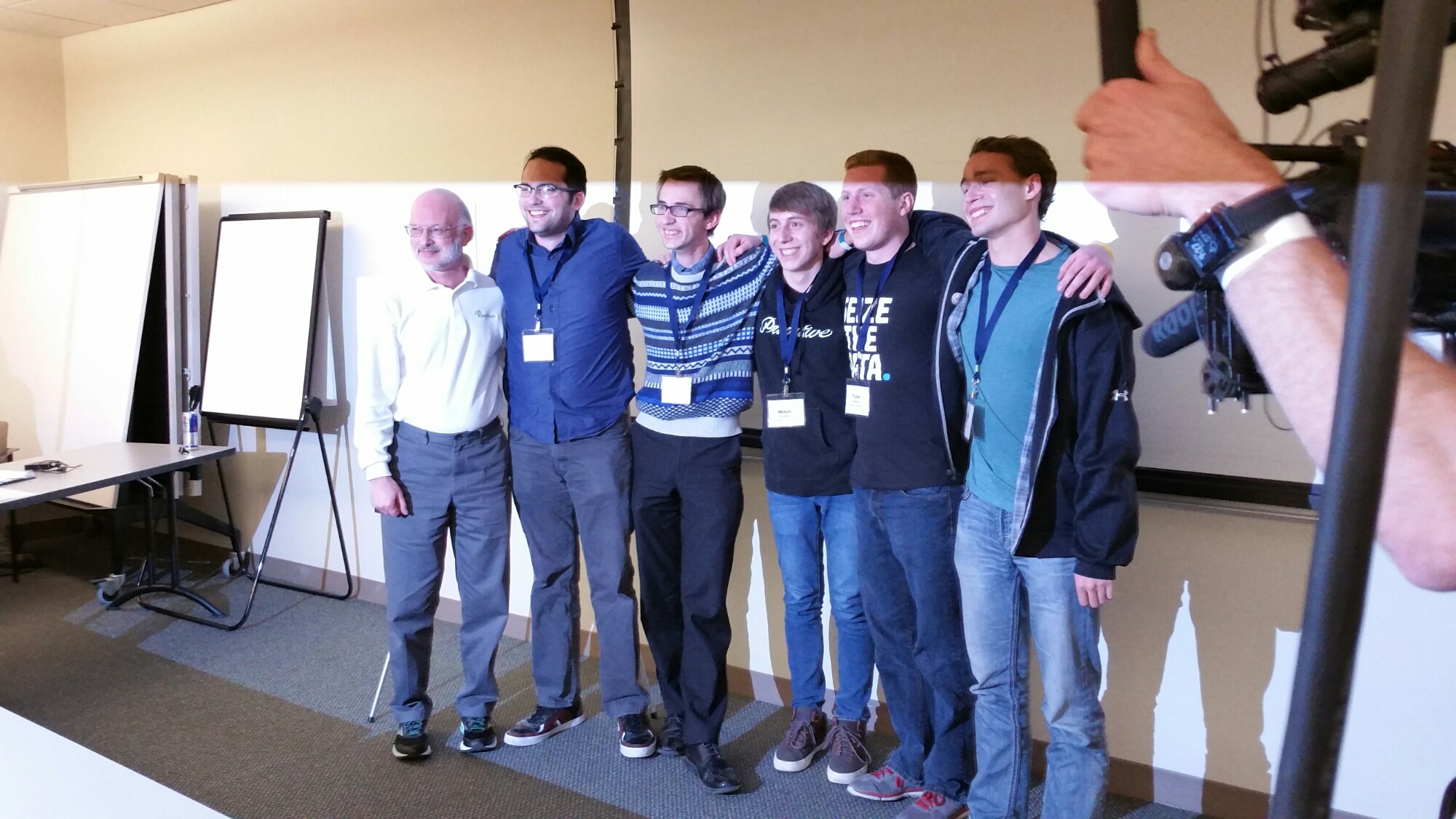
CourtHack in Salt Lake City with the National Center for State Courts
Earlier this month, I was lucky enough to be a judge at the CourtHack hackathon in Salt Lake City, sponsored by the National Center for State Courts. The event brought a whole room full of technologists and lawyers together,…
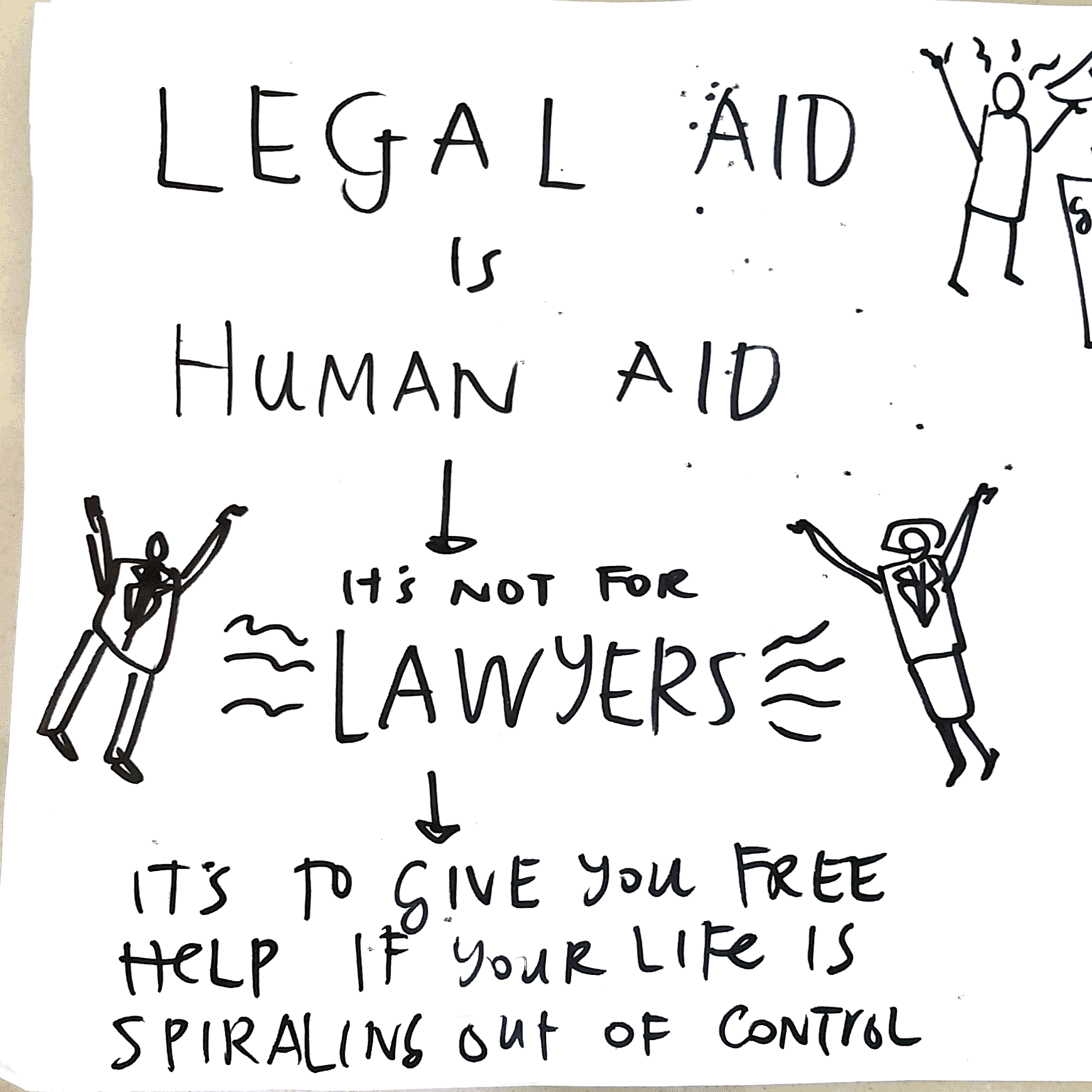
Branding access to justice
I was going back through my notebook from conferences I’ve been at for the past few months. One of the themes I was sketching out was about branding legal aid. How we can make access to justice and improving…
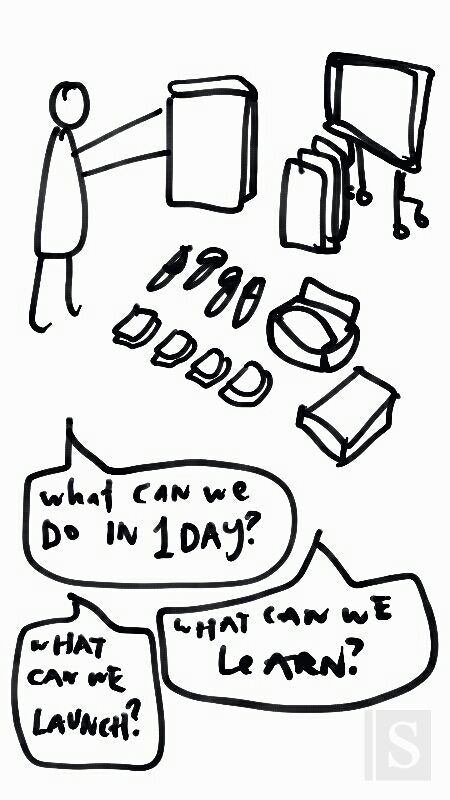
Rapid prototyping on-site for access to justice designs
As I plan out what I might teach next quarter, I’m increasingly decided against having another classroom-based design class. I want to be in the field, where the users and service-providers of the legal system are, and where we…
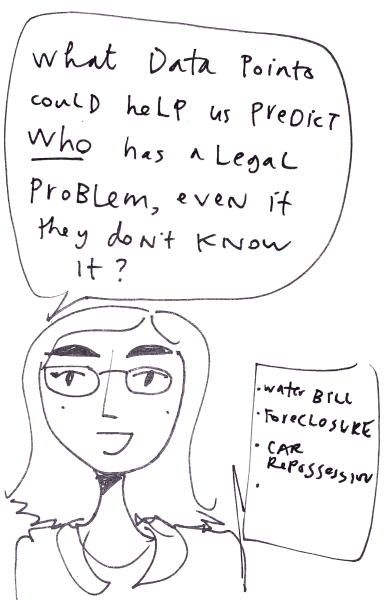
Using Open Data Sources to Seek Out People with Legal Problems
One of the most exciting ideas that came out of last month’s Legal Services Corporation/Technology Innovation Grants conference in San Antonio was the idea of using data to engage people with legal problems to use the legal system to…
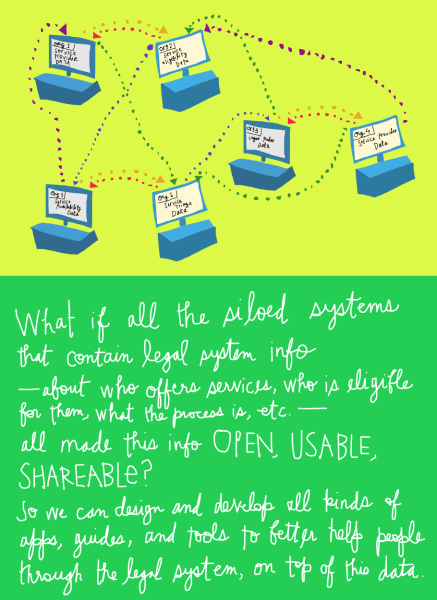
Open, Coordinated Data and the User Experience of Law
I have a much longer post on this coming — but after the session I ran last week at the Legal Services Corporation’s Technology Innovation Grant conference in San Antonio along with Greg Bloom of the Open Referral Initiative,…
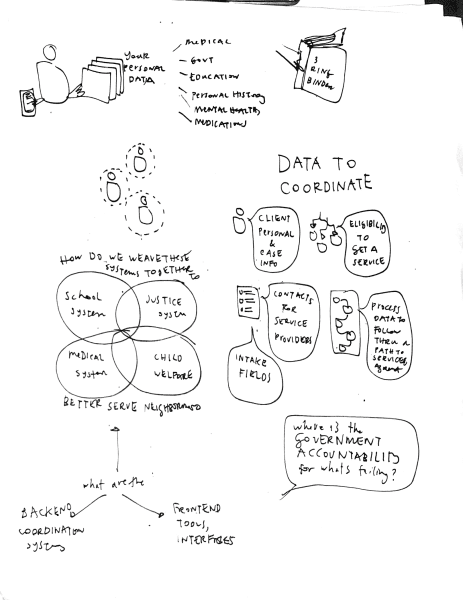
Coordinating client & legal services data for better access to justice
Last week I spoke on a panel of access to justice & technology at the Google/Baker McKenzie event, the Children’s Rights Summit. The goal was to explore how the tech sector could come together with the legal sector to…
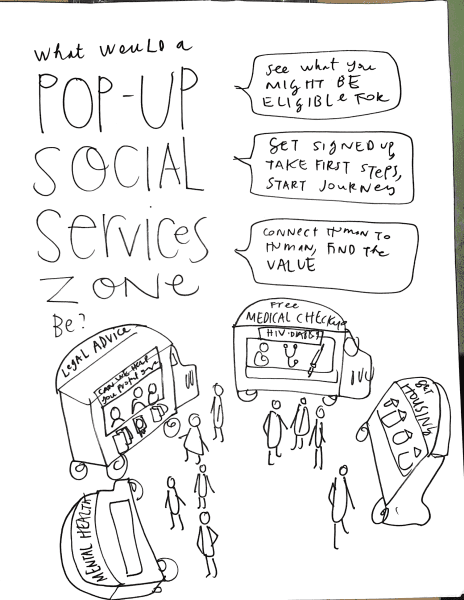
City-center pop-up legal and social service parks
Last Friday I was a guest judge at a d.school program on the future of cities. I was responding to student teams’ proposals for ‘Tactical Urbanism’ projects in San Francisco, to make the city a better place to live…
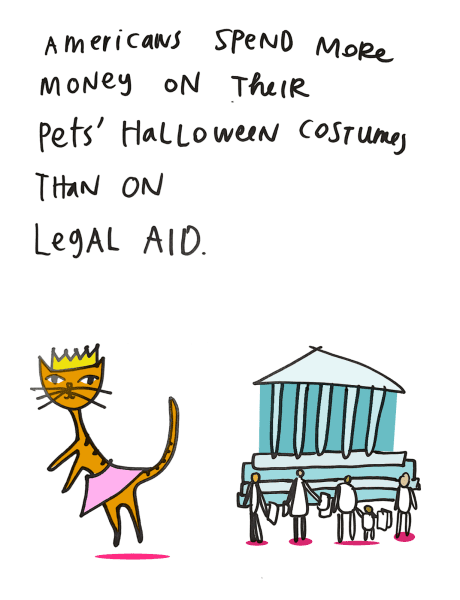
Access to Justice movement 2.0
Why doesn’t it resonate with more Americans that we need a better justice system, that gives equal & universal access to all people who need to use law to deal with their life problems? Why don’t we have huge…
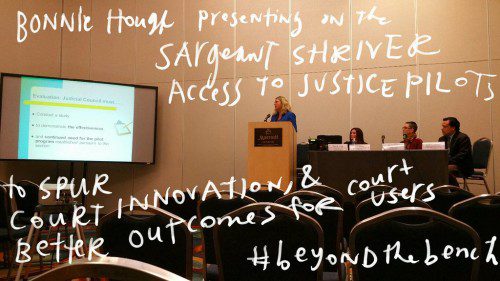
Sargent Shriver free lawyers for civil legal needs pilot program
Today at the Judicial Council’s Beyond the Bench conference on innovations and user experience in family law & the justice system, I had the privilege to hear a presentation from Bonnie Hough & 3 different lawyers on the Sarget…
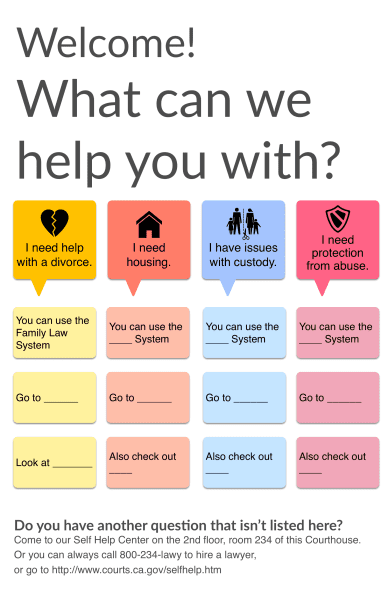
Welcome to Court! Triage poster #beyondthebench
This poster is my slightly improved version of a paper-sharpie-poster concept from yesterday’s Beyond The Bench user centered legal services design workshop. I led it with a small team from the Legal Design Lab. We posed the challenge to…
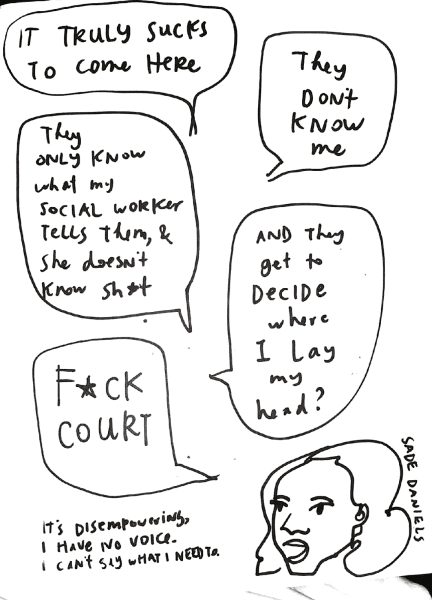
F#*$ Court – a foster youth feedback
The voice of Sade Daniels, about what it feels like to go through the court system as a foster youth, at the Plenary of Beyond the Bench.
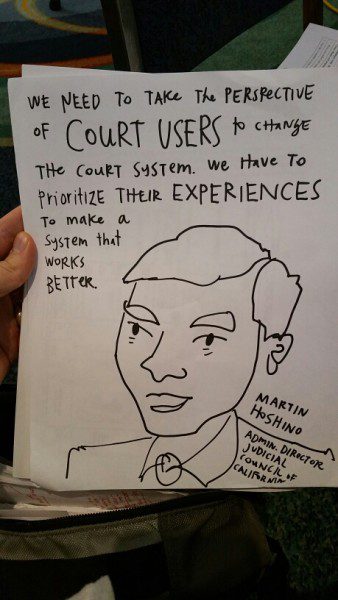
Listening to Court Users
Setting the tone of a priority on User Experience at the California Beyond the Bench conference. This quote is from Administrative Director Martin Hoshino, about the need to put users’ point of view central to the court staff’s work.
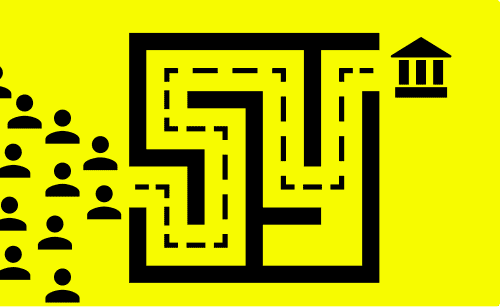
The legal system needs to be redesigned, by normal people for normal people
Today I had the pleasure of hearing LSC President Jim Sandman speak to a conference hall full of Legal Service Providers from Floria, at the Florida 2015 Legal Aid Summit. He reinforced one big message at the end: the…
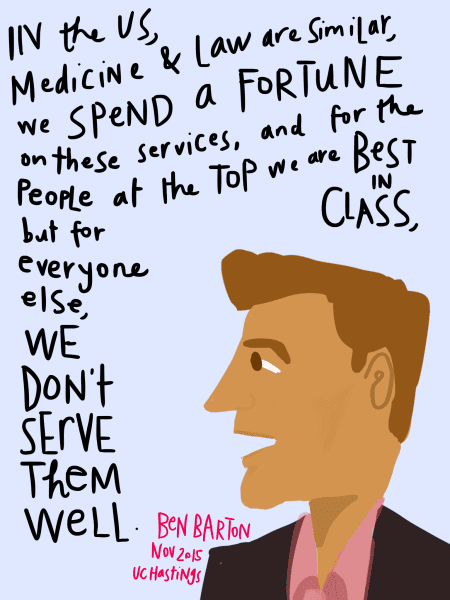
How law and medicine in the US share the same fundamental crisis
Some insights from Ben Barton at the UCHastings Equal Access to Justice conference, about the convergence of the same massive problem in the US legal and medical systems.
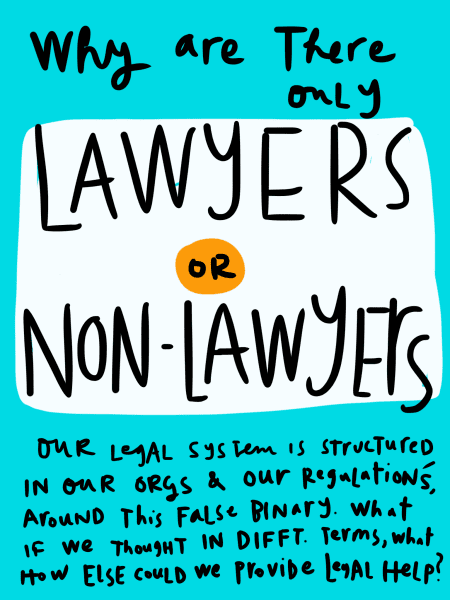
Getting beyond Lawyers vs Non-lawyers
A thought in the room, at the conference at UCHastings on equal access to justice. Justice Goodwin Liu made a comment along these lines, seconded by other speakers.
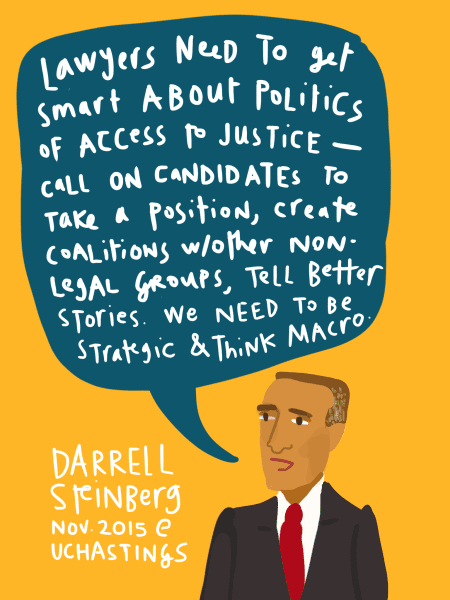
Thinking macro on Access to Justice strategy
Darrell Steinberg speaking at UCHastings about how we in the access to justice movement can be more strategic, more impactful, and more politically savvy.
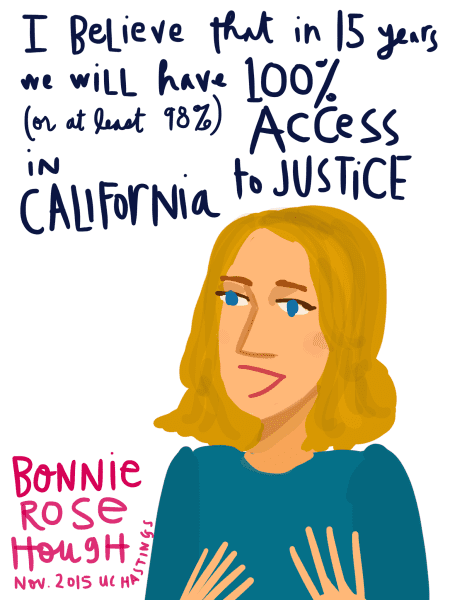
Getting to 100% Access to Justice
A vision from the Judicial Council’s Bonnie Hough at the UCHastings conference on equal access to justice.
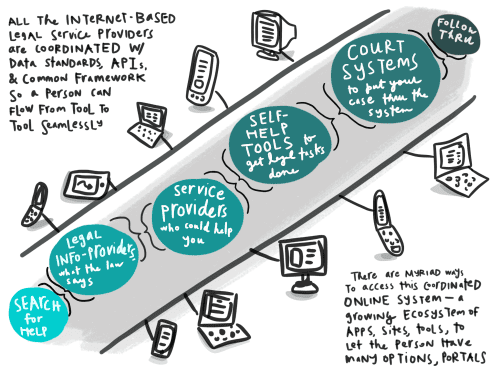
Simple at the front, Smart at the back: design for access to justice innovation
A colleague working on improving the legal system in New Zealand from a user-centered design perspective mentioned this phrase to me in a recent email: Simple at the Front, Smart at the Back. Now it’s my constant refrain. What…
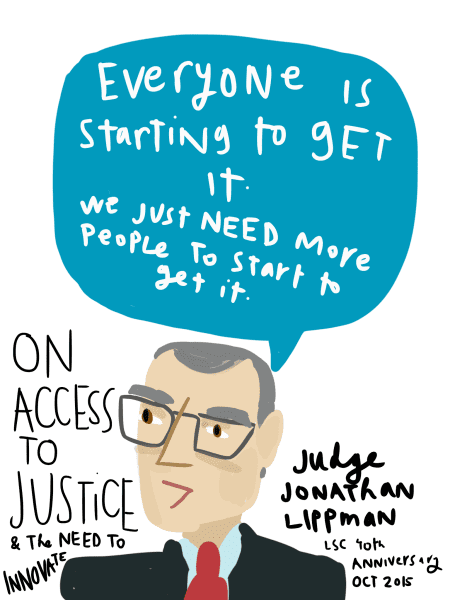
Everyone is starting to get it: innovating access to justice
Here is a small sketch I made while listening to talks at the Legal Service Corporation’s 40th Anniversary celebration in downtown San Francisco last month. It was from Justice Jonathan Lippman, the Chief Judge of NY’s Court of Appeals….
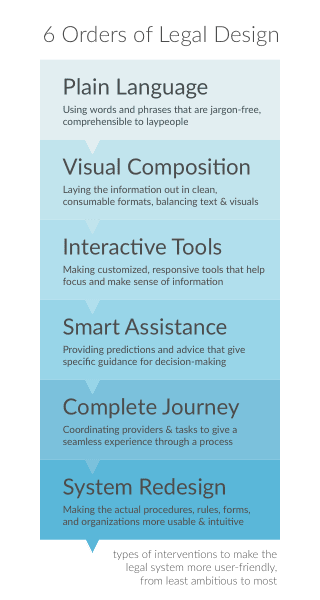
6 orders of legal design: how we can intervene in the legal system to improve it
I’ve been thinking systematically over the past few months, as I’ve been looking back over design work and initiatives going on in the world of legal innovation, and bringing design into law. Here’s one of the schematics I’ve created,…
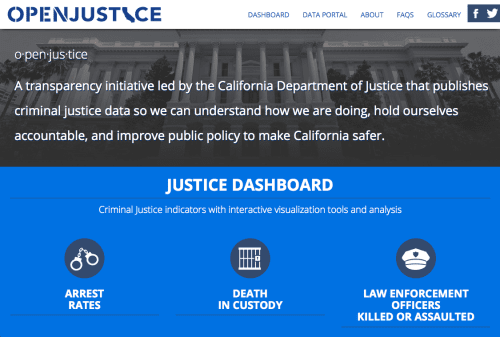
OpenJustice: open data from the California Department of Justice
I was excited to discover the OpenJustice Initiative, a move from the California DOJ to make its data more open, and provide a basis for more usable tools, interfaces, and processes for people who interact with the DOJ. See…
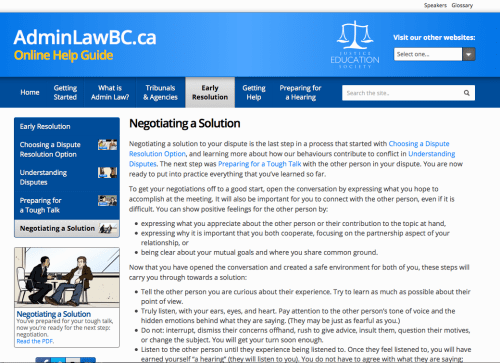
User-friendly legal services from British Columbia
Talking to Bonnie Hough of the California Judicial Council last week, she recommended checking out several great projects coming out of Canada — specifically British Columbia — for inspiration about how courts can be more user-friendly. Many of them…
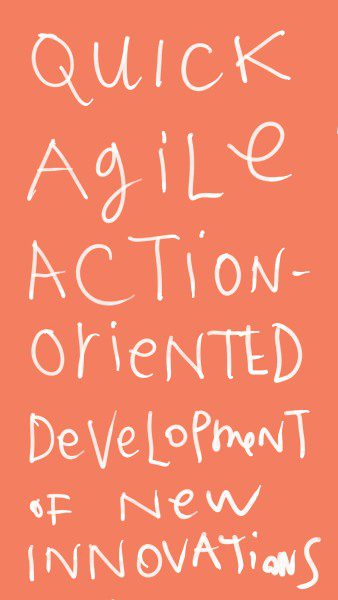
Moving Legal Innovation from Waterfall to Agile
How can we develop new solutions in agile, responsive ways? So that if we see a problem or hear a user need — that we take action, try something in a lightweight way, small way — a hack, rather…
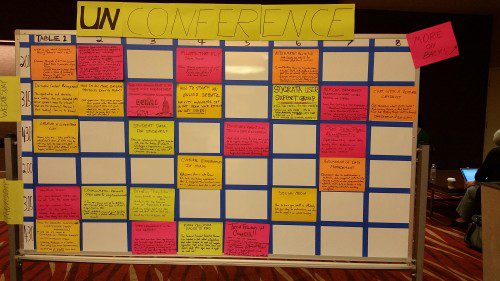
Court innovations at the Code for America Summit
I’m excited to be speaking at the Code For America Summit this week in Oakland — and trying to make the bridge between the robust & big-energy civic tech world, and the world of legal innovation. Very excited to…
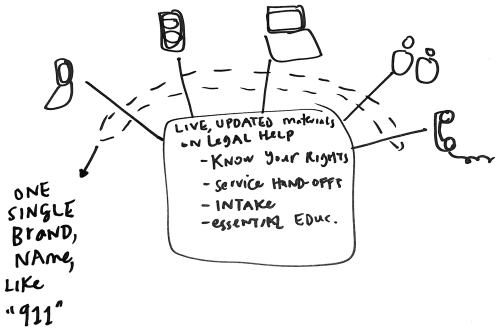
My (sketched) vision of the future of accessible legal services
How can we help people on-ramp into the legal system in much easier & accessible ways? This is the solution that’s been growing in my mind (but still obviously a little rough) over the last few months. We need…
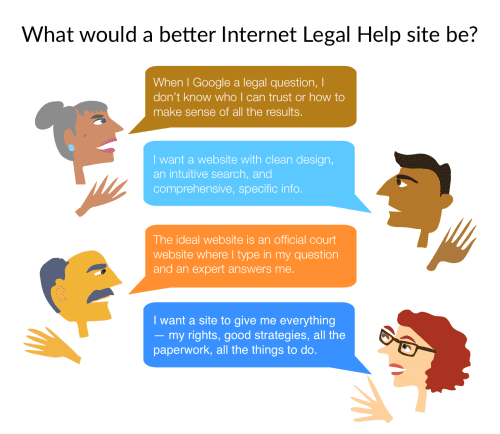
What would a better Internet for Legal Help look like?
This week I have been finishing up my research paper on what user-centered standards for better online legal help sites would be. I had surveyed lay adults about how they’ve used the Internet in the past to respond to…
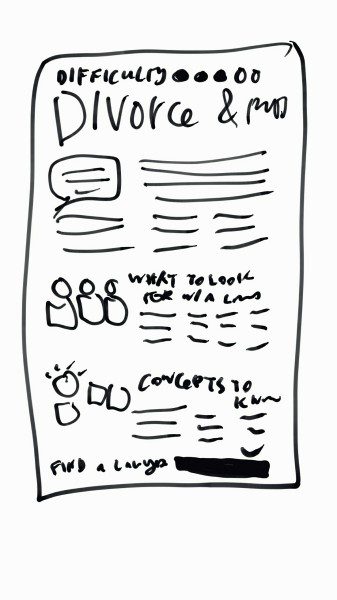
Sketches for Self-Help worksheets
I have been sketching out some possible templates for what a good one-pager worksheet would be, to guide a lay person through a legal process. Obviously the one-pager has enormous limits, so instead of thinking about it as a…
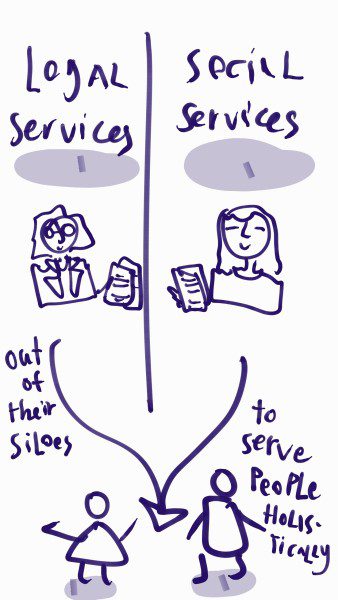
How can social service providers to get people to legal help?
During my Spring 2015 class at Stanford d.school/Law School on Intro to Legal Design, we were lucky enough to have Sacha Steinberger visit us and present on her Project Legal Link. I drew up some notes during her presentation,…
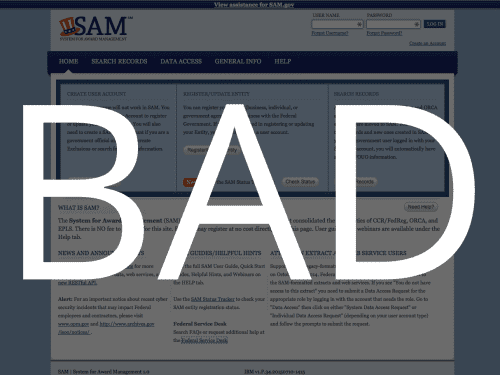
Why are government and court websites so bad?
I was delighted that one of my favorite new podcasts, Reply All, spent an episode in August all about horrible government websites (see Sam.gov as prime example 1) — and how they got that way. When we talk about…
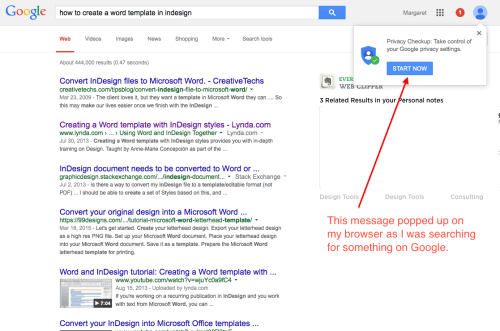
Legal Health Checkup Interventions
A few weeks ago, when I logged into my browser, I got a notice from Google that they wanted to walk me through a Privacy Checkup of my Google Account. I agreed, more to observe how they treated me…

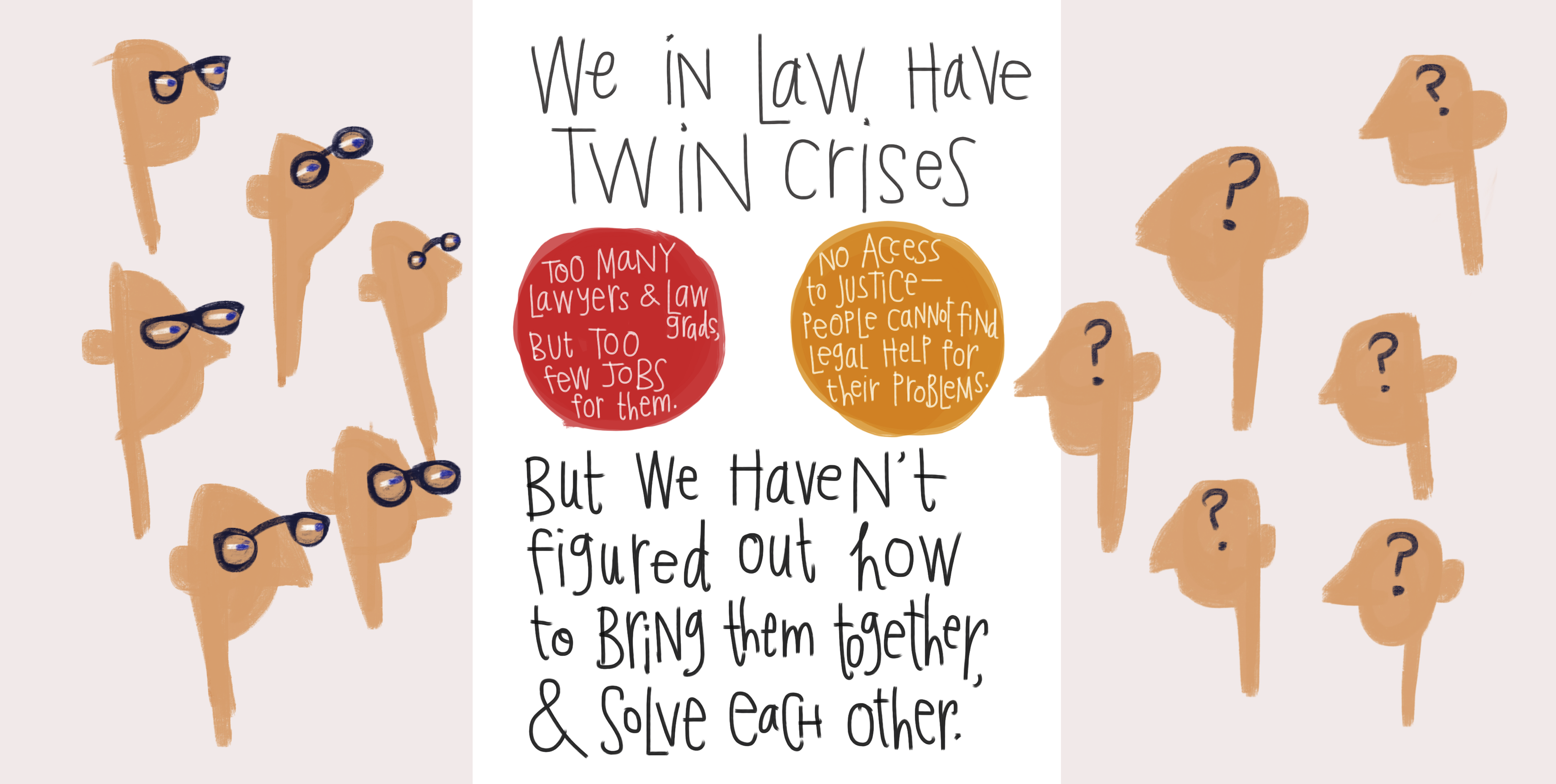
4 Comments
[…] As Margaret Hagan put it, visually: […]
[…] We are hoping to develop some collaborative design projects with Margaret over the coming months – so stay tuned. For more information about Margaret Hagan’s work, go to http://www.openlawlab.com/project-topics/access-to-justice-innovations/ […]
[…] As Margaret Hagan put it, visually: […]
[…] Open Law Lab – a blog on designing human-centered justice innovation […]